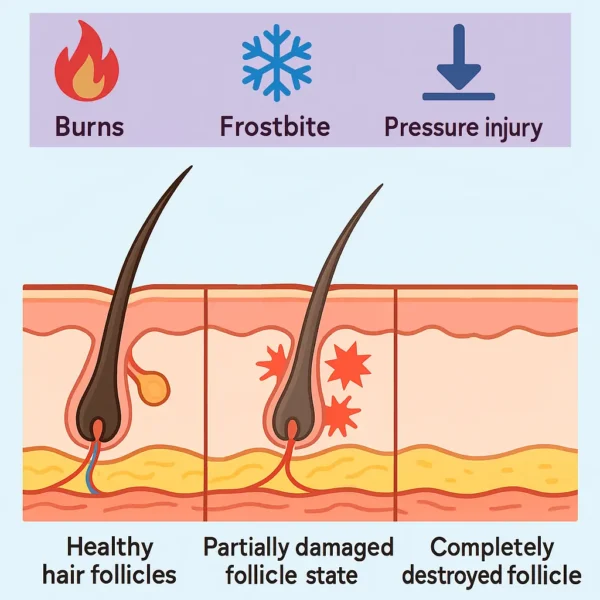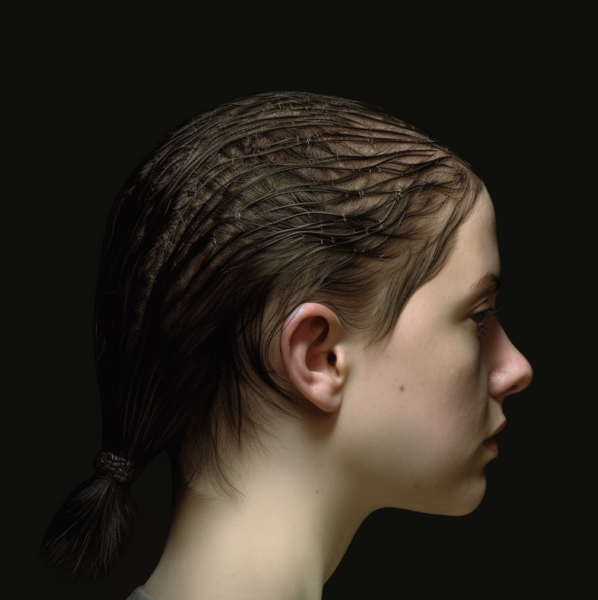Hair looks deceptively tough, yet each shaft emerges from a remarkably delicate “mini‑organ” embedded in the skin. Humans are born with a set number of these hair follicles, and – outside of research laboratories – we cannot spontaneously generate new ones the way we regenerate skin or blood. That finite supply means that any event destroying a follicle risks creating a permanently bald patch. Physical trauma such as burns, long‑term frostbite, prolonged pressure during surgery or intensive‑care immobilisation, all threaten follicles in subtly different ways. This article explains what happens inside the skin during such injuries, why some hair grows back while other areas stay forever bare, how modern medicine can prevent or repair the damage, and what experimental breakthroughs may one day allow true follicle regeneration.
A Limited Lifetimes Supply of Follicles and Why That Matters: During the second trimester of pregnancy, coordinated chemical “conversations” between embryonic epidermis and underlying mesenchyme trigger hair placodes and, later, fully formed follicles. After birth that developmental window closes; adult skin simply lacks the signalling environment needed to restart organogenesis. Thus every follicle lost through physical trauma is, for practical purposes, irreplaceable. Even though follicles cycle between growth, regression and rest throughout life, their survival depends on a tiny reservoir of epithelial stem cells in the bulge and a matching cluster of specialised dermal papilla fibroblasts. If either population is destroyed, the follicle’s self‑renewal loop is broken and hair cannot return.
Burns and Frostbite, Degrees of Damage, Degrees of Hair Loss: Thermal injury illustrates the spectrum of outcomes to hair follicle damage. Superficial contact with a curling iron may singe hair shafts, and there may be some skin redness and inflammation, but the underlying follicle is mostly spared. After a while, the hair follicle will regrow and the singed fiber will be replaced. By contrast, burns from flames, boiling water scalding, or chemical burns that penetrate the full thickness of skin can obliterate the follicular stem‑cell niche altogether. As a result, the follicle is destroyed and it can no longer make hair fiber. Similar principles apply to frostbite: brief exposure that merely numbs the ears often triggers a transient “resting” (telogen) phase, whereas severe, long‑duration cold literally freezes the dermis, rupturing cell membranes and vascular supply. In these deep injuries there is simply no follicle left to regrow hair.
Pressure‑Induced Alopecia, When Immobilisation Starves Follicles: Prolonged external pressure to the skin is a quieter, but surprisingly common route to hair loss. During lengthy surgery, intensive‑care ventilation or even a long gaming session with a tight headset, the scalp skin can be compressed against a hard surface. Blood capillary flow falls below the 32 mm Hg perfusion threshold, hypoxia sets in, and follicular keratinocytes begin to die. Where the pressure lasts for a prolonged period of time, there can be permanent skin injury and destruction of hair follicles. The resulting bald patch typically appears one to four weeks later; often on the occiput in adults or the vertex in infants. A 2025 case report following eight‑hour breast‑reconstruction surgery highlighted the problem: a 3 × 4 cm occipital plaque became apparent at four weeks, causing significant patient distress despite an otherwise good surgical outcome.
Prevention: Small Positioning Changes, Big Difference: Because pressure alopecia is largely preventable, peri‑operative guidelines have evolved. The Association of periOperative Registered Nurses (AORN) recommends viscoelastic gel headrests, high‑frequency repositioning (every 30 minutes when feasible) and scalp massage or infrared warming post‑operatively to boost micro‑circulation. Duration of immobilisation remains the single biggest risk factor: operations exceeding three hours or ICU sedation beyond 48 hours warrant heightened vigilance. Awareness campaigns in anaesthesia journals stress that hair loss, though not life‑threatening, undermines patient satisfaction and can be mistaken for autoimmune alopecia areata unless the surgical team documents the risk clearly in discharge notes.
When Surviving Follicles Choose Dormancy Over Growth: Not all burns and prolonged pressure create irreversible hair loss. Mild or moderate thermal damage, or limited pressure injury, often leaves hair follicles structurally intact yet triggers a cocktail of inflammatory cytokines – chemical signals including interleukins, TNF‑α, prostaglandins – that put neighbouring follicles into prolonged sleep. The phenomenon is a specialised form of telogen effluvium; hair shafts shed two to six weeks after injury, but new anagen growth is delayed until the pro‑inflammatory milieu subsides. In many patients regrowth begins within four to six months without intervention. Dermatologists sometimes prescribe topical minoxidil to shorten the dormancy period.
Follicles as First Responders and Their Role in Wound Healing: Paradoxically, hair follicles do not merely suffer during wounding; they also help repair the damage. Within hours of a cut or partial‑thickness burn, bulge‑derived keratinocytes and melanocyte progenitors migrate out to reseed the epidermis, while dermal papilla cells secrete growth factors that stimulate angiogenesis. Animal studies using lineage tracing have confirmed that up to 30 % of new epidermal cells overlying a scab originate from adjacent follicles. This emergency‑healing duty is thought to explain why growing hair slows or stops around fresh wounds; the follicle temporarily re‑allocates its stem‑cell reserves to wound healing and ignores its hair growth role.
Repairing Permanent Scars with Modern Transplantation Techniques: With extensive burns, the primary objective is to cover the damaged skin with grafts. The main aim is to recover the skin barrier function, to protect the body and the internal organs. Consequently, in these situations where the burns injury has occurred to the scalp or other hair bearing regions of skin, the surgical team are not necessarily thinking about how to replace hair. Burn centres focus on staged excision of the damaged skin tissues, and skin grafting within the first 72 hours. Where there is healthy skin elsewhere on the body, the surgeons may attempt a split thickness skin graft, where some tissue is sliced from the upper skin surface and moved to the burned area. While grafted skin closes the wound and saves life, it usually arrives hair free because donor follicles are trimmed away to aid re vascularisation.
When follicles are irrevocably lost from the scalp – whether from a flame burn or a pressure ulcer that progressed to skin necrosis – hair transplantation remains the mainstay of cosmetic restoration. Over the past decade follicular‑unit excision (FUE) has supplanted older punch grafts, allowing surgeons to harvest individual follicles with minimal scarring and angle them naturally into scar tissue. Adjunctive platelet‑rich plasma (PRP) injections and nanofat grafting may improve the blood vascularity of the recipient bed, increasing graft take in cicatricial alopecia by up to 20 % in a recent study series. Scalp tissue expansion, long reserved for large paediatric burns, is now complemented by dermal‑regeneration templates that reduce expansion time and donor‑site morbidity.
Looking Ahead Towards True Follicle Regeneration: A comprehensive 2025 review in Stem Cell Research & Therapy summarised three promising avenues: (1) laboratory assembly of “hair follicle germs” from induced pluripotent stem cells and dermal papilla spheroids; (2) scaffold‑free organoid cultures that spontaneously form concentric follicle‑like structures; and (3) hybrid bioprinting that deposits epithelial and mesenchymal cells side‑by‑side in hydrogel filaments. Each strategy faces hurdles – chiefly, recreating the cyclical signalling environment that keeps follicles cycling for decades – but the pace of progress is accelerating. The same review notes that single‑cell RNA sequencing has mapped virtually every cell type involved, creating a molecular blueprint for future tissue engineers.
Conclusions: Physical injury can silence or destroy hair follicles, but the outcome depends on injury depth, duration and timely medical care. Superficial burns and brief cold exposure usually trigger a reversible resting phase telogen effluvium, whereas full‑thickness burns and prolonged pressure leave a permanent scarring alopecia. Modern operating‑room practices – gel cushions, head repositioning, hypothermia avoidance – can almost eliminate pressure induced alopecia, yet awareness of these protocols among health professionals is still catching up. For those already scarred, refined FUE transplantation and biologic adjuncts offer natural‑looking repair. Beyond today’s clinic, stem‑cell therapies and 3‑D printed, hair‑bearing skin point toward an era in the future when follicles lost to trauma may be genuinely replaced rather than merely redistributed. Until then, preventing deep injury and protecting the scalp during long surgical procedures remain the surest ways to keep the hair we already have.
Bibliography
11711645 {11711645:JGCSJ2HJ},{11711645:Z8X5Y5T7},{11711645:JNEIUSSX},{11711645:M22BYKAW},{11711645:VUAGTIHP},{11711645:V56JEM72},{11711645:55WNDCNU},{11711645:2UVH5NZC},{11711645:RGPTN5RV},{11711645:HWHQIFHL},{11711645:G4NEP7GT},{11711645:VYW33WHJ},{11711645:8BJZYWP2},{11711645:F75D567J},{11711645:QIJSZCPN},{11711645:4NEVGQHV},{11711645:SA9LDD7Z},{11711645:GNHWQ9ZJ},{11711645:8TG72D4I},{11711645:LLQZVGBV},{11711645:XMUS8D9V},{11711645:LQQ9CEDD} 1 vancouver 50 date asc 1905 https://www.keratin.com/wp-content/plugins/zotpress/ %7B%22status%22%3A%22success%22%2C%22updateneeded%22%3Afalse%2C%22instance%22%3Afalse%2C%22meta%22%3A%7B%22request_last%22%3A0%2C%22request_next%22%3A0%2C%22used_cache%22%3Atrue%7D%2C%22data%22%3A%5B%7B%22key%22%3A%22M22BYKAW%22%2C%22library%22%3A%7B%22id%22%3A11711645%7D%2C%22meta%22%3A%7B%22creatorSummary%22%3A%22Gormley%20and%20Sokoll%22%2C%22parsedDate%22%3A%221967-03-06%22%2C%22numChildren%22%3A0%7D%2C%22bib%22%3A%22%26lt%3Bdiv%20class%3D%26quot%3Bcsl-bib-body%26quot%3B%20style%3D%26quot%3Bline-height%3A%201.35%3B%20%26quot%3B%26gt%3B%5Cn%20%20%26lt%3Bdiv%20class%3D%26quot%3Bcsl-entry%26quot%3B%20style%3D%26quot%3Bclear%3A%20left%3B%20%26quot%3B%26gt%3B%5Cn%20%20%20%20%26lt%3Bdiv%20class%3D%26quot%3Bcsl-left-margin%26quot%3B%20style%3D%26quot%3Bfloat%3A%20left%3B%20padding-right%3A%200.5em%3B%20text-align%3A%20right%3B%20width%3A%201em%3B%26quot%3B%26gt%3B1.%26lt%3B%5C%2Fdiv%26gt%3B%26lt%3Bdiv%20class%3D%26quot%3Bcsl-right-inline%26quot%3B%20style%3D%26quot%3Bmargin%3A%200%20.4em%200%201.5em%3B%26quot%3B%26gt%3BGormley%20TP%2C%20Sokoll%20MD.%20Permanent%20alopecia%20from%20pressure%20of%20a%20head%20strap.%20JAMA.%201967%20Mar%206%3B199%2810%29%3A747%26%23x2013%3B8.%26lt%3B%5C%2Fdiv%26gt%3B%5Cn%20%20%20%26lt%3B%5C%2Fdiv%26gt%3B%5Cn%26lt%3B%5C%2Fdiv%26gt%3B%22%2C%22data%22%3A%7B%22itemType%22%3A%22journalArticle%22%2C%22title%22%3A%22Permanent%20alopecia%20from%20pressure%20of%20a%20head%20strap%22%2C%22creators%22%3A%5B%7B%22creatorType%22%3A%22author%22%2C%22firstName%22%3A%22T.%20P.%22%2C%22lastName%22%3A%22Gormley%22%7D%2C%7B%22creatorType%22%3A%22author%22%2C%22firstName%22%3A%22M.%20D.%22%2C%22lastName%22%3A%22Sokoll%22%7D%5D%2C%22abstractNote%22%3A%22%22%2C%22date%22%3A%221967-03-06%22%2C%22language%22%3A%22eng%22%2C%22DOI%22%3A%22%22%2C%22ISSN%22%3A%220098-7484%22%2C%22url%22%3A%22%22%2C%22collections%22%3A%5B%2299MPMJ5N%22%5D%2C%22dateModified%22%3A%222025-07-25T16%3A06%3A02Z%22%7D%7D%2C%7B%22key%22%3A%22VUAGTIHP%22%2C%22library%22%3A%7B%22id%22%3A11711645%7D%2C%22meta%22%3A%7B%22creatorSummary%22%3A%22Kosanin%20et%20al.%22%2C%22parsedDate%22%3A%221984-02%22%2C%22numChildren%22%3A0%7D%2C%22bib%22%3A%22%26lt%3Bdiv%20class%3D%26quot%3Bcsl-bib-body%26quot%3B%20style%3D%26quot%3Bline-height%3A%201.35%3B%20%26quot%3B%26gt%3B%5Cn%20%20%26lt%3Bdiv%20class%3D%26quot%3Bcsl-entry%26quot%3B%20style%3D%26quot%3Bclear%3A%20left%3B%20%26quot%3B%26gt%3B%5Cn%20%20%20%20%26lt%3Bdiv%20class%3D%26quot%3Bcsl-left-margin%26quot%3B%20style%3D%26quot%3Bfloat%3A%20left%3B%20padding-right%3A%200.5em%3B%20text-align%3A%20right%3B%20width%3A%201em%3B%26quot%3B%26gt%3B1.%26lt%3B%5C%2Fdiv%26gt%3B%26lt%3Bdiv%20class%3D%26quot%3Bcsl-right-inline%26quot%3B%20style%3D%26quot%3Bmargin%3A%200%20.4em%200%201.5em%3B%26quot%3B%26gt%3BKosanin%20RM%2C%20Riefkohl%20R%2C%20Barwick%20WJ.%20Postoperative%20alopecia%20in%20a%20woman%20after%20a%20lengthy%20plastic%20surgical%20procedure.%20Plast%20Reconstr%20Surg.%201984%20Feb%3B73%282%29%3A308%26%23x2013%3B9.%26lt%3B%5C%2Fdiv%26gt%3B%5Cn%20%20%20%26lt%3B%5C%2Fdiv%26gt%3B%5Cn%26lt%3B%5C%2Fdiv%26gt%3B%22%2C%22data%22%3A%7B%22itemType%22%3A%22journalArticle%22%2C%22title%22%3A%22Postoperative%20alopecia%20in%20a%20woman%20after%20a%20lengthy%20plastic%20surgical%20procedure%22%2C%22creators%22%3A%5B%7B%22creatorType%22%3A%22author%22%2C%22firstName%22%3A%22R.%20M.%22%2C%22lastName%22%3A%22Kosanin%22%7D%2C%7B%22creatorType%22%3A%22author%22%2C%22firstName%22%3A%22R.%22%2C%22lastName%22%3A%22Riefkohl%22%7D%2C%7B%22creatorType%22%3A%22author%22%2C%22firstName%22%3A%22W.%20J.%22%2C%22lastName%22%3A%22Barwick%22%7D%5D%2C%22abstractNote%22%3A%22Pressure-induced%20alopecia%20was%20reported%20in%20the%20past.%20We%20observed%20postoperative%20alopecia%20%28presumably%20pressure-induced%29%20after%20a%20plastic%20surgical%20procedure%20of%20a%20long%20duration.%20Shortly%20after%20the%20operation%2C%20the%20patient%20noted%20swelling%20and%20exudation%20of%20the%20scalp%20near%20the%20vertex.%20The%20symptoms%20abated%20in%20the%20course%20of%20a%20week.%20The%20hair%20loss%20occurred%20quite%20rapidly%20%28within%2048%20hours%29%20in%20the%20area%20of%20the%20previous%20symptoms%20on%20the%20sixth%20postoperative%20day.%20Irregular%20regrowth%20of%20short%20hairs%20was%20first%20noted%20after%206%20weeks.%20The%20patient%26%23039%3Bs%20last%20examination%2010%20weeks%20after%20the%20operation%20revealed%20a%204%20x%204%20cm%20area%20of%20baldness%20with%20few%20scattered%20hairs%205%20to%206%20mm%20in%20length.%20The%20cause%20is%20considered%20to%20be%20pressure-induced%20ischemia%20based%20on%20the%20following%3A%20preceding%20period%20of%20deep%20unconsciousness%20%28the%20operation%29%20and%20natural%20history%20of%20the%20disease.%22%2C%22date%22%3A%221984-02%22%2C%22language%22%3A%22eng%22%2C%22DOI%22%3A%2210.1097%5C%2F00006534-198402000-00031%22%2C%22ISSN%22%3A%220032-1052%22%2C%22url%22%3A%22%22%2C%22collections%22%3A%5B%2299MPMJ5N%22%5D%2C%22dateModified%22%3A%222025-07-25T16%3A05%3A39Z%22%7D%7D%2C%7B%22key%22%3A%22V56JEM72%22%2C%22library%22%3A%7B%22id%22%3A11711645%7D%2C%22meta%22%3A%7B%22creatorSummary%22%3A%22Wiles%20and%20Hansen%22%2C%22parsedDate%22%3A%221985-01%22%2C%22numChildren%22%3A0%7D%2C%22bib%22%3A%22%26lt%3Bdiv%20class%3D%26quot%3Bcsl-bib-body%26quot%3B%20style%3D%26quot%3Bline-height%3A%201.35%3B%20%26quot%3B%26gt%3B%5Cn%20%20%26lt%3Bdiv%20class%3D%26quot%3Bcsl-entry%26quot%3B%20style%3D%26quot%3Bclear%3A%20left%3B%20%26quot%3B%26gt%3B%5Cn%20%20%20%20%26lt%3Bdiv%20class%3D%26quot%3Bcsl-left-margin%26quot%3B%20style%3D%26quot%3Bfloat%3A%20left%3B%20padding-right%3A%200.5em%3B%20text-align%3A%20right%3B%20width%3A%201em%3B%26quot%3B%26gt%3B1.%26lt%3B%5C%2Fdiv%26gt%3B%26lt%3Bdiv%20class%3D%26quot%3Bcsl-right-inline%26quot%3B%20style%3D%26quot%3Bmargin%3A%200%20.4em%200%201.5em%3B%26quot%3B%26gt%3BWiles%20JC%2C%20Hansen%20RC.%20Postoperative%20%28pressure%29%20alopecia.%20J%20Am%20Acad%20Dermatol.%201985%20Jan%3B12%281%20Pt%202%29%3A195%26%23x2013%3B8.%26lt%3B%5C%2Fdiv%26gt%3B%5Cn%20%20%20%26lt%3B%5C%2Fdiv%26gt%3B%5Cn%26lt%3B%5C%2Fdiv%26gt%3B%22%2C%22data%22%3A%7B%22itemType%22%3A%22journalArticle%22%2C%22title%22%3A%22Postoperative%20%28pressure%29%20alopecia%22%2C%22creators%22%3A%5B%7B%22creatorType%22%3A%22author%22%2C%22firstName%22%3A%22J.%20C.%22%2C%22lastName%22%3A%22Wiles%22%7D%2C%7B%22creatorType%22%3A%22author%22%2C%22firstName%22%3A%22R.%20C.%22%2C%22lastName%22%3A%22Hansen%22%7D%5D%2C%22abstractNote%22%3A%22Postoperative%20localized%20alopecia%20has%20been%20reported%20most%20commonly%20after%20certain%20gynecologic%20and%20open%20heart%20surgery%20procedures%2C%20the%20likelihood%20of%20hair%20loss%20and%20the%20chance%20of%20permanence%20correlating%20with%20the%20length%20of%20the%20anesthesia%20and%20the%20intubation.%20Some%20cases%20of%20pressure-induced%20alopecia%20have%20been%20described%20after%20prolonged%20coma%20from%20other%20causes.%20Coma%20blisters%20have%20been%20reported%20after%20drug%20overdoses%2C%20but%20clinically%20similar%20blisters%20%28not%20tested%20by%20biopsy%29%20have%20been%20seen%20in%20other%20cases%20of%20coma.%20We%20present%20three%20cases%20of%20postoperative%20%28pressure%29%20alopecia%20and%20propose%20that%20both%20coma%20blisters%20and%20postoperative%20alopecia%20arise%20from%20the%20same%20phenomenon--probably%20pressure-induced%20ischemia.%22%2C%22date%22%3A%221985-01%22%2C%22language%22%3A%22eng%22%2C%22DOI%22%3A%2210.1016%5C%2Fs0190-9622%2885%2980016-5%22%2C%22ISSN%22%3A%220190-9622%22%2C%22url%22%3A%22%22%2C%22collections%22%3A%5B%2299MPMJ5N%22%5D%2C%22dateModified%22%3A%222025-07-25T16%3A04%3A34Z%22%7D%7D%2C%7B%22key%22%3A%222UVH5NZC%22%2C%22library%22%3A%7B%22id%22%3A11711645%7D%2C%22meta%22%3A%7B%22creatorSummary%22%3A%22Felman%22%2C%22parsedDate%22%3A%221994-05%22%2C%22numChildren%22%3A0%7D%2C%22bib%22%3A%22%26lt%3Bdiv%20class%3D%26quot%3Bcsl-bib-body%26quot%3B%20style%3D%26quot%3Bline-height%3A%201.35%3B%20%26quot%3B%26gt%3B%5Cn%20%20%26lt%3Bdiv%20class%3D%26quot%3Bcsl-entry%26quot%3B%20style%3D%26quot%3Bclear%3A%20left%3B%20%26quot%3B%26gt%3B%5Cn%20%20%20%20%26lt%3Bdiv%20class%3D%26quot%3Bcsl-left-margin%26quot%3B%20style%3D%26quot%3Bfloat%3A%20left%3B%20padding-right%3A%200.5em%3B%20text-align%3A%20right%3B%20width%3A%201em%3B%26quot%3B%26gt%3B1.%26lt%3B%5C%2Fdiv%26gt%3B%26lt%3Bdiv%20class%3D%26quot%3Bcsl-right-inline%26quot%3B%20style%3D%26quot%3Bmargin%3A%200%20.4em%200%201.5em%3B%26quot%3B%26gt%3BFelman%20G.%20Post-thermal%20burn%20alopecia%20and%20its%20treatment%20using%20extensive%20horizontal%20scalp%20reduction%20in%20combination%20with%20a%20Juri%20flap.%20Plast%20Reconstr%20Surg.%201994%20May%3B93%286%29%3A1268%26%23x2013%3B73.%26lt%3B%5C%2Fdiv%26gt%3B%5Cn%20%20%20%26lt%3B%5C%2Fdiv%26gt%3B%5Cn%26lt%3B%5C%2Fdiv%26gt%3B%22%2C%22data%22%3A%7B%22itemType%22%3A%22journalArticle%22%2C%22title%22%3A%22Post-thermal%20burn%20alopecia%20and%20its%20treatment%20using%20extensive%20horizontal%20scalp%20reduction%20in%20combination%20with%20a%20Juri%20flap%22%2C%22creators%22%3A%5B%7B%22creatorType%22%3A%22author%22%2C%22firstName%22%3A%22G.%22%2C%22lastName%22%3A%22Felman%22%7D%5D%2C%22abstractNote%22%3A%22The%20extensive%20horizontal%20scalp%20reduction%20technique%20with%20its%20difficulties%20and%20known%20limitations%20in%20relocation%20of%20flap%20and%20horizontal%20reduction%20was%20performed%20twice%20in%20combination%20with%20a%20Juri%20flap%20technique%20as%20treatment%20of%20wide%20scar%20alopecia%20resulting%20from%20a%20thermal%20burn.%20The%20dramatic%20effect%20achieved%20has%20left%20the%20patients%20as%20well%20as%20the%20surgeon%20satisfied%20with%20the%20cosmetic%20results.%22%2C%22date%22%3A%221994-05%22%2C%22language%22%3A%22eng%22%2C%22DOI%22%3A%2210.1097%5C%2F00006534-199405000-00026%22%2C%22ISSN%22%3A%220032-1052%22%2C%22url%22%3A%22%22%2C%22collections%22%3A%5B%2299MPMJ5N%22%5D%2C%22dateModified%22%3A%222025-07-25T16%3A03%3A00Z%22%7D%7D%2C%7B%22key%22%3A%22VYW33WHJ%22%2C%22library%22%3A%7B%22id%22%3A11711645%7D%2C%22meta%22%3A%7B%22creatorSummary%22%3A%22Marino%22%2C%22parsedDate%22%3A%221995-12%22%2C%22numChildren%22%3A0%7D%2C%22bib%22%3A%22%26lt%3Bdiv%20class%3D%26quot%3Bcsl-bib-body%26quot%3B%20style%3D%26quot%3Bline-height%3A%201.35%3B%20%26quot%3B%26gt%3B%5Cn%20%20%26lt%3Bdiv%20class%3D%26quot%3Bcsl-entry%26quot%3B%20style%3D%26quot%3Bclear%3A%20left%3B%20%26quot%3B%26gt%3B%5Cn%20%20%20%20%26lt%3Bdiv%20class%3D%26quot%3Bcsl-left-margin%26quot%3B%20style%3D%26quot%3Bfloat%3A%20left%3B%20padding-right%3A%200.5em%3B%20text-align%3A%20right%3B%20width%3A%201em%3B%26quot%3B%26gt%3B1.%26lt%3B%5C%2Fdiv%26gt%3B%26lt%3Bdiv%20class%3D%26quot%3Bcsl-right-inline%26quot%3B%20style%3D%26quot%3Bmargin%3A%200%20.4em%200%201.5em%3B%26quot%3B%26gt%3BMarino%20RV.%20Headband%20alopecia.%20Pediatrics.%201995%20Dec%3B96%286%29%3A1174.%26lt%3B%5C%2Fdiv%26gt%3B%5Cn%20%20%20%26lt%3B%5C%2Fdiv%26gt%3B%5Cn%26lt%3B%5C%2Fdiv%26gt%3B%22%2C%22data%22%3A%7B%22itemType%22%3A%22journalArticle%22%2C%22title%22%3A%22Headband%20alopecia%22%2C%22creators%22%3A%5B%7B%22creatorType%22%3A%22author%22%2C%22firstName%22%3A%22R.%20V.%22%2C%22lastName%22%3A%22Marino%22%7D%5D%2C%22abstractNote%22%3A%22%22%2C%22date%22%3A%221995-12%22%2C%22language%22%3A%22eng%22%2C%22DOI%22%3A%22%22%2C%22ISSN%22%3A%220031-4005%22%2C%22url%22%3A%22%22%2C%22collections%22%3A%5B%2299MPMJ5N%22%5D%2C%22dateModified%22%3A%222025-07-25T16%3A01%3A21Z%22%7D%7D%2C%7B%22key%22%3A%22F75D567J%22%2C%22library%22%3A%7B%22id%22%3A11711645%7D%2C%22meta%22%3A%7B%22creatorSummary%22%3A%22Chow%20et%20al.%22%2C%22parsedDate%22%3A%221996-05%22%2C%22numChildren%22%3A0%7D%2C%22bib%22%3A%22%26lt%3Bdiv%20class%3D%26quot%3Bcsl-bib-body%26quot%3B%20style%3D%26quot%3Bline-height%3A%201.35%3B%20%26quot%3B%26gt%3B%5Cn%20%20%26lt%3Bdiv%20class%3D%26quot%3Bcsl-entry%26quot%3B%20style%3D%26quot%3Bclear%3A%20left%3B%20%26quot%3B%26gt%3B%5Cn%20%20%20%20%26lt%3Bdiv%20class%3D%26quot%3Bcsl-left-margin%26quot%3B%20style%3D%26quot%3Bfloat%3A%20left%3B%20padding-right%3A%200.5em%3B%20text-align%3A%20right%3B%20width%3A%201em%3B%26quot%3B%26gt%3B1.%26lt%3B%5C%2Fdiv%26gt%3B%26lt%3Bdiv%20class%3D%26quot%3Bcsl-right-inline%26quot%3B%20style%3D%26quot%3Bmargin%3A%200%20.4em%200%201.5em%3B%26quot%3B%26gt%3BChow%20IJ%2C%20Balakrishnan%20C%2C%20Meininger%20MS.%20Alopecia%20of%20the%20unburned%20scalp.%20Burns.%201996%20May%3B22%283%29%3A250%26%23x2013%3B1.%26lt%3B%5C%2Fdiv%26gt%3B%5Cn%20%20%20%26lt%3B%5C%2Fdiv%26gt%3B%5Cn%26lt%3B%5C%2Fdiv%26gt%3B%22%2C%22data%22%3A%7B%22itemType%22%3A%22journalArticle%22%2C%22title%22%3A%22Alopecia%20of%20the%20unburned%20scalp%22%2C%22creators%22%3A%5B%7B%22creatorType%22%3A%22author%22%2C%22firstName%22%3A%22I.%20J.%22%2C%22lastName%22%3A%22Chow%22%7D%2C%7B%22creatorType%22%3A%22author%22%2C%22firstName%22%3A%22C.%22%2C%22lastName%22%3A%22Balakrishnan%22%7D%2C%7B%22creatorType%22%3A%22author%22%2C%22firstName%22%3A%22M.%20S.%22%2C%22lastName%22%3A%22Meininger%22%7D%5D%2C%22abstractNote%22%3A%22Alopecia%20of%20the%20unburned%20scalp%2C%20the%20temporary%20or%20permanent%20loss%20of%20hair%2C%20is%20a%20preventable%20complication.%20Patients%20at%20highest%20risk%20of%20developing%20alopecia%20are%20those%20with%20burn%20encephalopathy%20and%20in%20a%20prolonged%20shock%20state.%20The%20occipital%20scalp%20is%20the%20most%20common%20site%20and%20localized%20pressure-induced%20ischaemia%20is%20the%20likely%20cause.%20Frequent%20head%20repositioning%20and%20use%20of%20devices%20to%20decrease%20the%20pressure%20effect%20may%20decrease%20the%20incidence%20of%20this%20complication.%22%2C%22date%22%3A%221996-05%22%2C%22language%22%3A%22eng%22%2C%22DOI%22%3A%2210.1016%5C%2F0305-4179%2895%2900115-8%22%2C%22ISSN%22%3A%220305-4179%22%2C%22url%22%3A%22%22%2C%22collections%22%3A%5B%2299MPMJ5N%22%5D%2C%22dateModified%22%3A%222025-07-25T16%3A00%3A01Z%22%7D%7D%2C%7B%22key%22%3A%22QIJSZCPN%22%2C%22library%22%3A%7B%22id%22%3A11711645%7D%2C%22meta%22%3A%7B%22creatorSummary%22%3A%22Esposito%20and%20Dado%22%2C%22parsedDate%22%3A%221997%22%2C%22numChildren%22%3A0%7D%2C%22bib%22%3A%22%26lt%3Bdiv%20class%3D%26quot%3Bcsl-bib-body%26quot%3B%20style%3D%26quot%3Bline-height%3A%201.35%3B%20%26quot%3B%26gt%3B%5Cn%20%20%26lt%3Bdiv%20class%3D%26quot%3Bcsl-entry%26quot%3B%20style%3D%26quot%3Bclear%3A%20left%3B%20%26quot%3B%26gt%3B%5Cn%20%20%20%20%26lt%3Bdiv%20class%3D%26quot%3Bcsl-left-margin%26quot%3B%20style%3D%26quot%3Bfloat%3A%20left%3B%20padding-right%3A%200.5em%3B%20text-align%3A%20right%3B%20width%3A%201em%3B%26quot%3B%26gt%3B1.%26lt%3B%5C%2Fdiv%26gt%3B%26lt%3Bdiv%20class%3D%26quot%3Bcsl-right-inline%26quot%3B%20style%3D%26quot%3Bmargin%3A%200%20.4em%200%201.5em%3B%26quot%3B%26gt%3BEsposito%20C%2C%20Dado%20DV.%20The%20use%20of%20tissue%20expansion%20for%20the%20treatment%20of%20burn%20scar%20alopecia.%20Plast%20Surg%20Nurs.%201997%3B17%281%29%3A11%26%23x2013%3B5.%26lt%3B%5C%2Fdiv%26gt%3B%5Cn%20%20%20%26lt%3B%5C%2Fdiv%26gt%3B%5Cn%26lt%3B%5C%2Fdiv%26gt%3B%22%2C%22data%22%3A%7B%22itemType%22%3A%22journalArticle%22%2C%22title%22%3A%22The%20use%20of%20tissue%20expansion%20for%20the%20treatment%20of%20burn%20scar%20alopecia%22%2C%22creators%22%3A%5B%7B%22creatorType%22%3A%22author%22%2C%22firstName%22%3A%22C.%22%2C%22lastName%22%3A%22Esposito%22%7D%2C%7B%22creatorType%22%3A%22author%22%2C%22firstName%22%3A%22D.%20V.%22%2C%22lastName%22%3A%22Dado%22%7D%5D%2C%22abstractNote%22%3A%22Tissue%20expansion%20is%20an%20ideal%20reconstructive%20procedure%20for%20burn%20scar%20alopecia.%20Donor%20tissue%20is%20generated%20in%20situ%2C%20allowing%20for%20the%20use%20of%20hair-bearing%20tissue%20to%20reconstruct%20an%20area%20of%20alopecia.%20The%20process%20of%20tissue%20expansion%20results%20in%20a%20redistribution%20of%20the%20remaining%20hair%20follicles%20to%20replace%20the%20area%20of%20alopecia.%22%2C%22date%22%3A%221997%22%2C%22language%22%3A%22eng%22%2C%22DOI%22%3A%22%22%2C%22ISSN%22%3A%220741-5206%22%2C%22url%22%3A%22%22%2C%22collections%22%3A%5B%2299MPMJ5N%22%5D%2C%22dateModified%22%3A%222025-07-25T15%3A59%3A34Z%22%7D%7D%2C%7B%22key%22%3A%2255WNDCNU%22%2C%22library%22%3A%7B%22id%22%3A11711645%7D%2C%22meta%22%3A%7B%22creatorSummary%22%3A%22Fan%20and%20Yang%22%2C%22parsedDate%22%3A%221997%22%2C%22numChildren%22%3A0%7D%2C%22bib%22%3A%22%26lt%3Bdiv%20class%3D%26quot%3Bcsl-bib-body%26quot%3B%20style%3D%26quot%3Bline-height%3A%201.35%3B%20%26quot%3B%26gt%3B%5Cn%20%20%26lt%3Bdiv%20class%3D%26quot%3Bcsl-entry%26quot%3B%20style%3D%26quot%3Bclear%3A%20left%3B%20%26quot%3B%26gt%3B%5Cn%20%20%20%20%26lt%3Bdiv%20class%3D%26quot%3Bcsl-left-margin%26quot%3B%20style%3D%26quot%3Bfloat%3A%20left%3B%20padding-right%3A%200.5em%3B%20text-align%3A%20right%3B%20width%3A%201em%3B%26quot%3B%26gt%3B1.%26lt%3B%5C%2Fdiv%26gt%3B%26lt%3Bdiv%20class%3D%26quot%3Bcsl-right-inline%26quot%3B%20style%3D%26quot%3Bmargin%3A%200%20.4em%200%201.5em%3B%26quot%3B%26gt%3BFan%20J%2C%20Yang%20P.%20Aesthetic%20reconstruction%20of%20burn%20alopecia%20by%20using%20expanded%20hair-bearing%20scalp%20flaps.%20Aesthetic%20Plast%20Surg.%201997%3B21%286%29%3A440%26%23x2013%3B4.%26lt%3B%5C%2Fdiv%26gt%3B%5Cn%20%20%20%26lt%3B%5C%2Fdiv%26gt%3B%5Cn%26lt%3B%5C%2Fdiv%26gt%3B%22%2C%22data%22%3A%7B%22itemType%22%3A%22journalArticle%22%2C%22title%22%3A%22Aesthetic%20reconstruction%20of%20burn%20alopecia%20by%20using%20expanded%20hair-bearing%20scalp%20flaps%22%2C%22creators%22%3A%5B%7B%22creatorType%22%3A%22author%22%2C%22firstName%22%3A%22J.%22%2C%22lastName%22%3A%22Fan%22%7D%2C%7B%22creatorType%22%3A%22author%22%2C%22firstName%22%3A%22P.%22%2C%22lastName%22%3A%22Yang%22%7D%5D%2C%22abstractNote%22%3A%22Tissue%20expansion%20is%20one%20of%20the%20most%20important%20armamentaria%20for%20aesthetic%20scalp%20reconstruction%20after%20burn%3B%20however%2C%20the%20proper%20way%20to%20employ%20this%20technique%20for%20the%20scalp%20reconstruction%20usually%20presents%20a%20challenge%20to%20the%20plastic%20surgeon%2C%20especially%20in%20the%20case%20of%20a%20%26quot%3Bsideburn%26quot%3B%20scenario%20or%20a%20large%20lesion%2C%20as%20with%2C%20for%20example%2C%20hemiscalp%20alopecia.%20In%20this%20article%2C%2011%20patients%2C%20with%20different%20degrees%20of%20hair-bearing%20scalp%20loss%20as%20a%20result%20of%20burn%2C%20and%20including%20four%20patients%20with%20hemiscalp%20alopecia%20were%20successfully%20treated%20by%20using%20tissue%20expansion.%20The%20results%20show%20that%20tissue%20expansion%20is%20a%20simple%2C%20safe%2C%20and%20efficient%20technique%20for%20aesthetic%20scalp%20reconstruction.%20Versatile%20design%20of%20the%20expanded%20scalp%20flap%20can%20distribute%20the%20expanded%20hair-bearing%20scalp%20properly%20in%20the%20reconstructed%20recipient%20site.%22%2C%22date%22%3A%221997%22%2C%22language%22%3A%22eng%22%2C%22DOI%22%3A%2210.1007%5C%2Fs002669900154%22%2C%22ISSN%22%3A%220364-216X%22%2C%22url%22%3A%22%22%2C%22collections%22%3A%5B%2299MPMJ5N%22%5D%2C%22dateModified%22%3A%222025-07-25T16%3A03%3A48Z%22%7D%7D%2C%7B%22key%22%3A%22SA9LDD7Z%22%2C%22library%22%3A%7B%22id%22%3A11711645%7D%2C%22meta%22%3A%7B%22creatorSummary%22%3A%22MacLennan%20et%20al.%22%2C%22parsedDate%22%3A%221998-11%22%2C%22numChildren%22%3A0%7D%2C%22bib%22%3A%22%26lt%3Bdiv%20class%3D%26quot%3Bcsl-bib-body%26quot%3B%20style%3D%26quot%3Bline-height%3A%201.35%3B%20%26quot%3B%26gt%3B%5Cn%20%20%26lt%3Bdiv%20class%3D%26quot%3Bcsl-entry%26quot%3B%20style%3D%26quot%3Bclear%3A%20left%3B%20%26quot%3B%26gt%3B%5Cn%20%20%20%20%26lt%3Bdiv%20class%3D%26quot%3Bcsl-left-margin%26quot%3B%20style%3D%26quot%3Bfloat%3A%20left%3B%20padding-right%3A%200.5em%3B%20text-align%3A%20right%3B%20width%3A%201em%3B%26quot%3B%26gt%3B1.%26lt%3B%5C%2Fdiv%26gt%3B%26lt%3Bdiv%20class%3D%26quot%3Bcsl-right-inline%26quot%3B%20style%3D%26quot%3Bmargin%3A%200%20.4em%200%201.5em%3B%26quot%3B%26gt%3BMacLennan%20SE%2C%20Kitzmiller%20WJ%2C%20Mertens%20D%2C%20Warden%20GD%2C%20Neale%20HW.%20Scalp%20autografts%20and%20hair%20transfer%20to%20the%20face%20in%20the%20burned%20child.%20Plast%20Reconstr%20Surg.%201998%20Nov%3B102%286%29%3A1865%26%23x2013%3B8.%26lt%3B%5C%2Fdiv%26gt%3B%5Cn%20%20%20%26lt%3B%5C%2Fdiv%26gt%3B%5Cn%26lt%3B%5C%2Fdiv%26gt%3B%22%2C%22data%22%3A%7B%22itemType%22%3A%22journalArticle%22%2C%22title%22%3A%22Scalp%20autografts%20and%20hair%20transfer%20to%20the%20face%20in%20the%20burned%20child%22%2C%22creators%22%3A%5B%7B%22creatorType%22%3A%22author%22%2C%22firstName%22%3A%22S.%20E.%22%2C%22lastName%22%3A%22MacLennan%22%7D%2C%7B%22creatorType%22%3A%22author%22%2C%22firstName%22%3A%22W.%20J.%22%2C%22lastName%22%3A%22Kitzmiller%22%7D%2C%7B%22creatorType%22%3A%22author%22%2C%22firstName%22%3A%22D.%22%2C%22lastName%22%3A%22Mertens%22%7D%2C%7B%22creatorType%22%3A%22author%22%2C%22firstName%22%3A%22G.%20D.%22%2C%22lastName%22%3A%22Warden%22%7D%2C%7B%22creatorType%22%3A%22author%22%2C%22firstName%22%3A%22H.%20W.%22%2C%22lastName%22%3A%22Neale%22%7D%5D%2C%22abstractNote%22%3A%22Hair%20transfer%20from%20split-thickness%20skin%20grafts%20harvested%20from%20the%20scalp%20is%20not%20a%20widely%20reported%20problem.%20The%20authors%20present%20their%20experience%20with%20hair%20transfer%20from%20scalp%20autografts%20in%20a%20pediatric%20burn%20population%2C%20with%20particular%20emphasis%20on%20hair%20transfer%20to%20the%20face.%20They%20retrospectively%20reviewed%203307%20acute%20and%20reconstructive%20pediatric%20burn%20admissions%20over%20a%204-year%20period%20at%20a%20single%20institution%20and%20identified%20109%20cases%20in%20which%20the%20scalp%20had%20been%20used%20as%20a%20donor%20site%20and%20in%20which%20the%20patient%20survived%20the%20acute%20burn%20period.%20Data%20from%2073%20male%20and%2036%20female%20patients%20were%20analyzed%20with%20respect%20to%20age%2C%20race%2C%20sex%2C%20percent%20total%20body%20surface%20area%20burned%2C%20graft%20thickness%2C%20number%20of%20scalp%20harvests%20and%20time%20between%20harvests%2C%20and%20presence%20of%20donor%20site%20alopecia.%20Eighteen%20of%20the%20109%20patients%20had%20noticeable%20hair%20growth%20from%20their%20scalp%20grafts%20%2817%20percent%29.%20Fourteen%20of%2018%20cases%20of%20hair%20growth%20involved%20face%20or%20neck%20grafts%20%2813%20percent%29%3B%20the%20remaining%204%20patients%20had%20hair%20growth%20elsewhere%20on%20the%20body.%20There%20was%20no%20difference%20between%20the%20two%20groups%20%28hair%20growth%20versus%20no%20hair%20growth%29%20when%20compared%20by%20age%2C%20sex%2C%20or%20graft%20thickness.%20There%20was%20a%20correlation%20between%20larger%20burn%20size%20and%20greater%20incidence%20of%20hair%20growth.%20Those%20who%20had%20multiple%20harvests%20of%20the%20same%20scalp%20donor%20site%20were%20more%20than%20twice%20as%20likely%20to%20have%20hair%20transfer%20%289%20of%2034%20versus%209%20of%2075%20patients%29%2C%20although%20time%20between%20harvests%20was%20not%20a%20significant%20variable.%20Caucasian%20children%20represented%2077%20percent%20of%20the%20study%20population%20yet%20100%20percent%20of%20the%20cases%20of%20problem%20hair%20growth.%20Thirty-three%20percent%20of%20the%20hair%20growth%20group%20%286%20of%2018%20patients%29%20and%204%20percent%20of%20the%20remaining%20patients%20%284%20of%2091%29%20had%20some%20degree%20of%20donor%20site%20alopecia.%20The%20scalp%20is%20a%20reliable%20and%20valuable%20donor%20site%20for%20skin%20grafting%20in%20children%2C%20particularly%20for%20facial%20burns.%20The%20authors%20note%20a%20moderate%20incidence%20of%20hair%20transfer%20%2817%20percent%29%20and%20propose%20both%20suggestions%20for%20prevention%20and%20recommendations%20for%20management.%22%2C%22date%22%3A%221998-11%22%2C%22language%22%3A%22eng%22%2C%22DOI%22%3A%2210.1097%5C%2F00006534-199811000-00009%22%2C%22ISSN%22%3A%220032-1052%22%2C%22url%22%3A%22%22%2C%22collections%22%3A%5B%2299MPMJ5N%22%5D%2C%22dateModified%22%3A%222025-07-25T15%3A57%3A58Z%22%7D%7D%2C%7B%22key%22%3A%228TG72D4I%22%2C%22library%22%3A%7B%22id%22%3A11711645%7D%2C%22meta%22%3A%7B%22creatorSummary%22%3A%22Barrera%22%2C%22parsedDate%22%3A%221999-02%22%2C%22numChildren%22%3A0%7D%2C%22bib%22%3A%22%26lt%3Bdiv%20class%3D%26quot%3Bcsl-bib-body%26quot%3B%20style%3D%26quot%3Bline-height%3A%201.35%3B%20%26quot%3B%26gt%3B%5Cn%20%20%26lt%3Bdiv%20class%3D%26quot%3Bcsl-entry%26quot%3B%20style%3D%26quot%3Bclear%3A%20left%3B%20%26quot%3B%26gt%3B%5Cn%20%20%20%20%26lt%3Bdiv%20class%3D%26quot%3Bcsl-left-margin%26quot%3B%20style%3D%26quot%3Bfloat%3A%20left%3B%20padding-right%3A%200.5em%3B%20text-align%3A%20right%3B%20width%3A%201em%3B%26quot%3B%26gt%3B1.%26lt%3B%5C%2Fdiv%26gt%3B%26lt%3Bdiv%20class%3D%26quot%3Bcsl-right-inline%26quot%3B%20style%3D%26quot%3Bmargin%3A%200%20.4em%200%201.5em%3B%26quot%3B%26gt%3BBarrera%20A.%20The%20use%20of%20micrografts%20and%20minigrafts%20for%20the%20treatment%20of%20burn%20alopecia.%20Plast%20Reconstr%20Surg.%201999%20Feb%3B103%282%29%3A581%26%23x2013%3B4.%26lt%3B%5C%2Fdiv%26gt%3B%5Cn%20%20%20%26lt%3B%5C%2Fdiv%26gt%3B%5Cn%26lt%3B%5C%2Fdiv%26gt%3B%22%2C%22data%22%3A%7B%22itemType%22%3A%22journalArticle%22%2C%22title%22%3A%22The%20use%20of%20micrografts%20and%20minigrafts%20for%20the%20treatment%20of%20burn%20alopecia%22%2C%22creators%22%3A%5B%7B%22creatorType%22%3A%22author%22%2C%22firstName%22%3A%22A.%22%2C%22lastName%22%3A%22Barrera%22%7D%5D%2C%22abstractNote%22%3A%22%22%2C%22date%22%3A%221999-02%22%2C%22language%22%3A%22eng%22%2C%22DOI%22%3A%2210.1097%5C%2F00006534-199902000-00034%22%2C%22ISSN%22%3A%220032-1052%22%2C%22url%22%3A%22%22%2C%22collections%22%3A%5B%2299MPMJ5N%22%5D%2C%22dateModified%22%3A%222025-07-25T15%3A55%3A07Z%22%7D%7D%2C%7B%22key%22%3A%22LLQZVGBV%22%2C%22library%22%3A%7B%22id%22%3A11711645%7D%2C%22meta%22%3A%7B%22creatorSummary%22%3A%22Moreno-Arias%20and%20Camps-Fresneda%22%2C%22parsedDate%22%3A%221999-05%22%2C%22numChildren%22%3A0%7D%2C%22bib%22%3A%22%26lt%3Bdiv%20class%3D%26quot%3Bcsl-bib-body%26quot%3B%20style%3D%26quot%3Bline-height%3A%201.35%3B%20%26quot%3B%26gt%3B%5Cn%20%20%26lt%3Bdiv%20class%3D%26quot%3Bcsl-entry%26quot%3B%20style%3D%26quot%3Bclear%3A%20left%3B%20%26quot%3B%26gt%3B%5Cn%20%20%20%20%26lt%3Bdiv%20class%3D%26quot%3Bcsl-left-margin%26quot%3B%20style%3D%26quot%3Bfloat%3A%20left%3B%20padding-right%3A%200.5em%3B%20text-align%3A%20right%3B%20width%3A%201em%3B%26quot%3B%26gt%3B1.%26lt%3B%5C%2Fdiv%26gt%3B%26lt%3Bdiv%20class%3D%26quot%3Bcsl-right-inline%26quot%3B%20style%3D%26quot%3Bmargin%3A%200%20.4em%200%201.5em%3B%26quot%3B%26gt%3BMoreno-Arias%20GA%2C%20Camps-Fresneda%20A.%20Hair%20grafting%20in%20postburn%20alopecia.%20Dermatol%20Surg.%201999%20May%3B25%285%29%3A412%26%23x2013%3B4.%26lt%3B%5C%2Fdiv%26gt%3B%5Cn%20%20%20%26lt%3B%5C%2Fdiv%26gt%3B%5Cn%26lt%3B%5C%2Fdiv%26gt%3B%22%2C%22data%22%3A%7B%22itemType%22%3A%22journalArticle%22%2C%22title%22%3A%22Hair%20grafting%20in%20postburn%20alopecia%22%2C%22creators%22%3A%5B%7B%22creatorType%22%3A%22author%22%2C%22firstName%22%3A%22G.%20A.%22%2C%22lastName%22%3A%22Moreno-Arias%22%7D%2C%7B%22creatorType%22%3A%22author%22%2C%22firstName%22%3A%22A.%22%2C%22lastName%22%3A%22Camps-Fresneda%22%7D%5D%2C%22abstractNote%22%3A%22BACKGROUND%3A%20Hair%20micrografting%20has%20been%20widely%20used%20in%20male%20and%20female%20androgenetic%20alopecia%20but%20there%20is%20little%20experience%20with%20cicatricial%20or%20burn%20alopecia.%5CnOBJECTIVE%3A%20To%20evaluate%20the%20clinical%20outcome%20of%20a%20case%20of%20postburn%20alopecia%20with%20marked%20inelastic%20affected%20areas%20but%20with%20good%20elasticity%20and%20hair%20density%20over%20occipital%20donor%20site%2C%20treated%20with%20multiple%20sessions%20of%20hair%20micrografting.%5CnMETHODS%3A%20Single-hair%20micrografts%20were%20employed%20to%20reconstruct%20the%20hair%20line%20but%202-%20and%203-hair%20micrografts%20were%20implanted%20over%20other%20alopecic%20areas.%20Grafts%20were%20placed%20into%20oblique%20slits%20made%20with%20N%20degrees%2015%20scalpel%20blade%20bevelled%20due%20to%20reduced%20dermis%20in%20the%20recipient%20area.%20Donor%20site%20was%20closed%20with%20vertical%20mattress%20and%20running%20suture%20with%203-0%20silk.%5CnRESULTS%3A%20In%204%20sessions%206500%20micrografts%20were%20implanted%20into%20the%20affected%20areas%2C%20achieving%20a%20natural%20appearing%20hair%20line%20and%20a%20good%20cosmetic%20result.%5CnCONCLUSION%3A%20Hair%20micrografting%20is%20a%20promising%20restorative%20technique%20for%20inelastic%20plaques%20of%20postburn%20alopecia.%22%2C%22date%22%3A%221999-05%22%2C%22language%22%3A%22eng%22%2C%22DOI%22%3A%2210.1046%5C%2Fj.1524-4725.1999.08277.x%22%2C%22ISSN%22%3A%221076-0512%22%2C%22url%22%3A%22%22%2C%22collections%22%3A%5B%2299MPMJ5N%22%5D%2C%22dateModified%22%3A%222025-07-25T15%3A54%3A32Z%22%7D%7D%2C%7B%22key%22%3A%22XMUS8D9V%22%2C%22library%22%3A%7B%22id%22%3A11711645%7D%2C%22meta%22%3A%7B%22creatorSummary%22%3A%22Regev%20et%20al.%22%2C%22parsedDate%22%3A%222006-05%22%2C%22numChildren%22%3A0%7D%2C%22bib%22%3A%22%26lt%3Bdiv%20class%3D%26quot%3Bcsl-bib-body%26quot%3B%20style%3D%26quot%3Bline-height%3A%201.35%3B%20%26quot%3B%26gt%3B%5Cn%20%20%26lt%3Bdiv%20class%3D%26quot%3Bcsl-entry%26quot%3B%20style%3D%26quot%3Bclear%3A%20left%3B%20%26quot%3B%26gt%3B%5Cn%20%20%20%20%26lt%3Bdiv%20class%3D%26quot%3Bcsl-left-margin%26quot%3B%20style%3D%26quot%3Bfloat%3A%20left%3B%20padding-right%3A%200.5em%3B%20text-align%3A%20right%3B%20width%3A%201em%3B%26quot%3B%26gt%3B1.%26lt%3B%5C%2Fdiv%26gt%3B%26lt%3Bdiv%20class%3D%26quot%3Bcsl-right-inline%26quot%3B%20style%3D%26quot%3Bmargin%3A%200%20.4em%200%201.5em%3B%26quot%3B%26gt%3BRegev%20E%2C%20Goldan%20O%2C%20Orenstein%20A%2C%20Winkler%20E%2C%20Haik%20J.%20Permanent%20pressure%20alopecia%20after%20microsurgical%20breast%20reconstruction.%20Plast%20Reconstr%20Surg.%202006%20May%3B117%286%29%3A2095%26%23x2013%3B6.%26lt%3B%5C%2Fdiv%26gt%3B%5Cn%20%20%20%26lt%3B%5C%2Fdiv%26gt%3B%5Cn%26lt%3B%5C%2Fdiv%26gt%3B%22%2C%22data%22%3A%7B%22itemType%22%3A%22journalArticle%22%2C%22title%22%3A%22Permanent%20pressure%20alopecia%20after%20microsurgical%20breast%20reconstruction%22%2C%22creators%22%3A%5B%7B%22creatorType%22%3A%22author%22%2C%22firstName%22%3A%22Eli%22%2C%22lastName%22%3A%22Regev%22%7D%2C%7B%22creatorType%22%3A%22author%22%2C%22firstName%22%3A%22Oren%22%2C%22lastName%22%3A%22Goldan%22%7D%2C%7B%22creatorType%22%3A%22author%22%2C%22firstName%22%3A%22Arie%22%2C%22lastName%22%3A%22Orenstein%22%7D%2C%7B%22creatorType%22%3A%22author%22%2C%22firstName%22%3A%22Eyal%22%2C%22lastName%22%3A%22Winkler%22%7D%2C%7B%22creatorType%22%3A%22author%22%2C%22firstName%22%3A%22Josef%22%2C%22lastName%22%3A%22Haik%22%7D%5D%2C%22abstractNote%22%3A%22%22%2C%22date%22%3A%222006-05%22%2C%22language%22%3A%22eng%22%2C%22DOI%22%3A%2210.1097%5C%2F01.prs.0000214754.01731.85%22%2C%22ISSN%22%3A%221529-4242%22%2C%22url%22%3A%22%22%2C%22collections%22%3A%5B%2299MPMJ5N%22%5D%2C%22dateModified%22%3A%222025-07-25T15%3A53%3A55Z%22%7D%7D%2C%7B%22key%22%3A%228BJZYWP2%22%2C%22library%22%3A%7B%22id%22%3A11711645%7D%2C%22meta%22%3A%7B%22creatorSummary%22%3A%22Iwai%20et%20al.%22%2C%22parsedDate%22%3A%222009-10%22%2C%22numChildren%22%3A0%7D%2C%22bib%22%3A%22%26lt%3Bdiv%20class%3D%26quot%3Bcsl-bib-body%26quot%3B%20style%3D%26quot%3Bline-height%3A%201.35%3B%20%26quot%3B%26gt%3B%5Cn%20%20%26lt%3Bdiv%20class%3D%26quot%3Bcsl-entry%26quot%3B%20style%3D%26quot%3Bclear%3A%20left%3B%20%26quot%3B%26gt%3B%5Cn%20%20%20%20%26lt%3Bdiv%20class%3D%26quot%3Bcsl-left-margin%26quot%3B%20style%3D%26quot%3Bfloat%3A%20left%3B%20padding-right%3A%200.5em%3B%20text-align%3A%20right%3B%20width%3A%201em%3B%26quot%3B%26gt%3B1.%26lt%3B%5C%2Fdiv%26gt%3B%26lt%3Bdiv%20class%3D%26quot%3Bcsl-right-inline%26quot%3B%20style%3D%26quot%3Bmargin%3A%200%20.4em%200%201.5em%3B%26quot%3B%26gt%3BIwai%20T%2C%20Matsui%20Y%2C%20Hirota%20M%2C%20Tohnai%20I%2C%20Maegawa%20J.%20Temporary%20alopecia%20caused%20by%20pressure%20from%20a%20headband%20used%20to%20secure%20a%20reference%20frame%20to%20the%20head%20during%20navigational%20surgery.%20Br%20J%20Oral%20Maxillofac%20Surg.%202009%20Oct%3B47%287%29%3A573%26%23x2013%3B4.%26lt%3B%5C%2Fdiv%26gt%3B%5Cn%20%20%20%26lt%3B%5C%2Fdiv%26gt%3B%5Cn%26lt%3B%5C%2Fdiv%26gt%3B%22%2C%22data%22%3A%7B%22itemType%22%3A%22journalArticle%22%2C%22title%22%3A%22Temporary%20alopecia%20caused%20by%20pressure%20from%20a%20headband%20used%20to%20secure%20a%20reference%20frame%20to%20the%20head%20during%20navigational%20surgery%22%2C%22creators%22%3A%5B%7B%22creatorType%22%3A%22author%22%2C%22firstName%22%3A%22Toshinori%22%2C%22lastName%22%3A%22Iwai%22%7D%2C%7B%22creatorType%22%3A%22author%22%2C%22firstName%22%3A%22Yoshiro%22%2C%22lastName%22%3A%22Matsui%22%7D%2C%7B%22creatorType%22%3A%22author%22%2C%22firstName%22%3A%22Makoto%22%2C%22lastName%22%3A%22Hirota%22%7D%2C%7B%22creatorType%22%3A%22author%22%2C%22firstName%22%3A%22Iwai%22%2C%22lastName%22%3A%22Tohnai%22%7D%2C%7B%22creatorType%22%3A%22author%22%2C%22firstName%22%3A%22Jiro%22%2C%22lastName%22%3A%22Maegawa%22%7D%5D%2C%22abstractNote%22%3A%22%22%2C%22date%22%3A%222009-10%22%2C%22language%22%3A%22eng%22%2C%22DOI%22%3A%2210.1016%5C%2Fj.bjoms.2009.02.019%22%2C%22ISSN%22%3A%221532-1940%22%2C%22url%22%3A%22%22%2C%22collections%22%3A%5B%2299MPMJ5N%22%5D%2C%22dateModified%22%3A%222025-07-25T16%3A01%3A13Z%22%7D%7D%2C%7B%22key%22%3A%22G4NEP7GT%22%2C%22library%22%3A%7B%22id%22%3A11711645%7D%2C%22meta%22%3A%7B%22creatorSummary%22%3A%22Davies%20and%20Yesudian%22%2C%22parsedDate%22%3A%222012-04%22%2C%22numChildren%22%3A0%7D%2C%22bib%22%3A%22%26lt%3Bdiv%20class%3D%26quot%3Bcsl-bib-body%26quot%3B%20style%3D%26quot%3Bline-height%3A%201.35%3B%20%26quot%3B%26gt%3B%5Cn%20%20%26lt%3Bdiv%20class%3D%26quot%3Bcsl-entry%26quot%3B%20style%3D%26quot%3Bclear%3A%20left%3B%20%26quot%3B%26gt%3B%5Cn%20%20%20%20%26lt%3Bdiv%20class%3D%26quot%3Bcsl-left-margin%26quot%3B%20style%3D%26quot%3Bfloat%3A%20left%3B%20padding-right%3A%200.5em%3B%20text-align%3A%20right%3B%20width%3A%201em%3B%26quot%3B%26gt%3B1.%26lt%3B%5C%2Fdiv%26gt%3B%26lt%3Bdiv%20class%3D%26quot%3Bcsl-right-inline%26quot%3B%20style%3D%26quot%3Bmargin%3A%200%20.4em%200%201.5em%3B%26quot%3B%26gt%3BDavies%20KE%2C%20Yesudian%20P.%20Pressure%20alopecia.%20Int%20J%20Trichology.%202012%20Apr%3B4%282%29%3A64%26%23x2013%3B8.%26lt%3B%5C%2Fdiv%26gt%3B%5Cn%20%20%20%26lt%3B%5C%2Fdiv%26gt%3B%5Cn%26lt%3B%5C%2Fdiv%26gt%3B%22%2C%22data%22%3A%7B%22itemType%22%3A%22journalArticle%22%2C%22title%22%3A%22Pressure%20alopecia%22%2C%22creators%22%3A%5B%7B%22creatorType%22%3A%22author%22%2C%22firstName%22%3A%22Kate%20E.%22%2C%22lastName%22%3A%22Davies%22%7D%2C%7B%22creatorType%22%3A%22author%22%2C%22firstName%22%3A%22Pd%22%2C%22lastName%22%3A%22Yesudian%22%7D%5D%2C%22abstractNote%22%3A%22Postoperative%20or%20pressure%20alopecia%20%28PA%29%20is%20an%20infrequently%20reported%20group%20of%20scarring%20and%20non-scarring%20alopecias.%20It%20has%20been%20reported%20after%20immobilization%20of%20the%20head%20during%20surgery%20and%20following%20prolonged%20stays%20on%20intensive%20care%20units%2C%20and%20may%20be%20analogous%20to%20a%20healed%20pressure%20ulcer.%20This%20review%20presents%20a%20summary%20of%20cases%20published%20in%20pediatrics%20and%20after%20cardiac%2C%20gynecological%2C%20abdominal%20and%20facial%20surgeries.%20PA%20may%20manifest%20as%20swelling%2C%20tenderness%2C%20and%20ulceration%20of%20the%20scalp%20in%20the%20first%20few%20postoperative%20days%3B%20in%20other%20cases%2C%20the%20alopecia%20may%20be%20the%20presenting%20feature%20with%20a%20history%20of%20scalp%20immobilization%20in%20the%20previous%20four%20weeks.%20The%20condition%20may%20cause%20considerable%20psychological%20distress%20in%20the%20long%20term.%20Regular%20head%20turning%20schedules%20and%20vigilance%20for%20the%20condition%20should%20be%20used%20as%20prophylaxis%20to%20prevent%20permanent%20alopecia.%20A%20multi-center%20study%20in%20high-risk%20patients%20would%20be%20beneficial%20to%20shed%20further%20light%20on%20the%20etiology%20of%20the%20condition.%22%2C%22date%22%3A%222012-04%22%2C%22language%22%3A%22eng%22%2C%22DOI%22%3A%2210.4103%5C%2F0974-7753.96901%22%2C%22ISSN%22%3A%220974-9241%22%2C%22url%22%3A%22%22%2C%22collections%22%3A%5B%2299MPMJ5N%22%5D%2C%22dateModified%22%3A%222025-07-25T16%3A01%3A33Z%22%7D%7D%2C%7B%22key%22%3A%22Z8X5Y5T7%22%2C%22library%22%3A%7B%22id%22%3A11711645%7D%2C%22meta%22%3A%7B%22creatorSummary%22%3A%22Goodenough%20et%20al.%22%2C%22parsedDate%22%3A%222014-08%22%2C%22numChildren%22%3A0%7D%2C%22bib%22%3A%22%26lt%3Bdiv%20class%3D%26quot%3Bcsl-bib-body%26quot%3B%20style%3D%26quot%3Bline-height%3A%201.35%3B%20%26quot%3B%26gt%3B%5Cn%20%20%26lt%3Bdiv%20class%3D%26quot%3Bcsl-entry%26quot%3B%20style%3D%26quot%3Bclear%3A%20left%3B%20%26quot%3B%26gt%3B%5Cn%20%20%20%20%26lt%3Bdiv%20class%3D%26quot%3Bcsl-left-margin%26quot%3B%20style%3D%26quot%3Bfloat%3A%20left%3B%20padding-right%3A%200.5em%3B%20text-align%3A%20right%3B%20width%3A%201em%3B%26quot%3B%26gt%3B1.%26lt%3B%5C%2Fdiv%26gt%3B%26lt%3Bdiv%20class%3D%26quot%3Bcsl-right-inline%26quot%3B%20style%3D%26quot%3Bmargin%3A%200%20.4em%200%201.5em%3B%26quot%3B%26gt%3BGoodenough%20J%2C%20Highgate%20J%2C%20Shaaban%20H.%20Under%20pressure%3F%20Alopecia%20related%20to%20surgical%20duration.%20Br%20J%20Anaesth.%202014%20Aug%3B113%282%29%3A306%26%23x2013%3B7.%26lt%3B%5C%2Fdiv%26gt%3B%5Cn%20%20%20%26lt%3B%5C%2Fdiv%26gt%3B%5Cn%26lt%3B%5C%2Fdiv%26gt%3B%22%2C%22data%22%3A%7B%22itemType%22%3A%22journalArticle%22%2C%22title%22%3A%22Under%20pressure%3F%20Alopecia%20related%20to%20surgical%20duration%22%2C%22creators%22%3A%5B%7B%22creatorType%22%3A%22author%22%2C%22firstName%22%3A%22J.%22%2C%22lastName%22%3A%22Goodenough%22%7D%2C%7B%22creatorType%22%3A%22author%22%2C%22firstName%22%3A%22J.%22%2C%22lastName%22%3A%22Highgate%22%7D%2C%7B%22creatorType%22%3A%22author%22%2C%22firstName%22%3A%22H.%22%2C%22lastName%22%3A%22Shaaban%22%7D%5D%2C%22abstractNote%22%3A%22%22%2C%22date%22%3A%222014-08%22%2C%22language%22%3A%22eng%22%2C%22DOI%22%3A%2210.1093%5C%2Fbja%5C%2Faeu252%22%2C%22ISSN%22%3A%221471-6771%22%2C%22url%22%3A%22%22%2C%22collections%22%3A%5B%2299MPMJ5N%22%5D%2C%22dateModified%22%3A%222025-07-25T16%3A13%3A17Z%22%7D%7D%2C%7B%22key%22%3A%22GNHWQ9ZJ%22%2C%22library%22%3A%7B%22id%22%3A11711645%7D%2C%22meta%22%3A%7B%22creatorSummary%22%3A%22Farjo%20et%20al.%22%2C%22parsedDate%22%3A%222015%22%2C%22numChildren%22%3A0%7D%2C%22bib%22%3A%22%26lt%3Bdiv%20class%3D%26quot%3Bcsl-bib-body%26quot%3B%20style%3D%26quot%3Bline-height%3A%201.35%3B%20%26quot%3B%26gt%3B%5Cn%20%20%26lt%3Bdiv%20class%3D%26quot%3Bcsl-entry%26quot%3B%20style%3D%26quot%3Bclear%3A%20left%3B%20%26quot%3B%26gt%3B%5Cn%20%20%20%20%26lt%3Bdiv%20class%3D%26quot%3Bcsl-left-margin%26quot%3B%20style%3D%26quot%3Bfloat%3A%20left%3B%20padding-right%3A%200.5em%3B%20text-align%3A%20right%3B%20width%3A%201em%3B%26quot%3B%26gt%3B1.%26lt%3B%5C%2Fdiv%26gt%3B%26lt%3Bdiv%20class%3D%26quot%3Bcsl-right-inline%26quot%3B%20style%3D%26quot%3Bmargin%3A%200%20.4em%200%201.5em%3B%26quot%3B%26gt%3BFarjo%20B%2C%20Farjo%20N%2C%20Williams%20G.%20Hair%20transplantation%20in%20burn%20scar%20alopecia.%20Scars%20Burn%20Heal.%202015%3B1%3A2059513115607764.%26lt%3B%5C%2Fdiv%26gt%3B%5Cn%20%20%20%26lt%3B%5C%2Fdiv%26gt%3B%5Cn%26lt%3B%5C%2Fdiv%26gt%3B%22%2C%22data%22%3A%7B%22itemType%22%3A%22journalArticle%22%2C%22title%22%3A%22Hair%20transplantation%20in%20burn%20scar%20alopecia%22%2C%22creators%22%3A%5B%7B%22creatorType%22%3A%22author%22%2C%22firstName%22%3A%22Bessam%22%2C%22lastName%22%3A%22Farjo%22%7D%2C%7B%22creatorType%22%3A%22author%22%2C%22firstName%22%3A%22Nilofer%22%2C%22lastName%22%3A%22Farjo%22%7D%2C%7B%22creatorType%22%3A%22author%22%2C%22firstName%22%3A%22Greg%22%2C%22lastName%22%3A%22Williams%22%7D%5D%2C%22abstractNote%22%3A%22Treating%20patients%20with%20burn%20alopecia%20or%20hair%20loss%20can%20often%20be%20a%20challenge%20to%20both%20the%20surgeon%20and%20the%20patient.%20As%20with%20other%20reconstructive%20procedures%20that%20are%20required%20in%20the%20post-burn%20phase%2C%20this%20is%20usually%20a%20multiple%20stage%20process%20often%20requiring%20surgery%20over%20several%20years.%20This%20is%20because%20graft%20take%20is%20not%20as%20reliable%20as%20in%20healthy%20non-scarred%20skin%20and%20may%20need%20repeating%20to%20achieve%20adequate%20density.%20Also%2C%20different%20areas%20of%20hair%20loss%20may%20need%20to%20be%20addressed%20in%20separate%20procedures.%20There%20are%20several%20limiting%20factors%20that%20will%20determine%20whether%20or%20not%20a%20patient%20is%20a%20candidate%20for%20hair%20restoration%20which%20includes%20but%20is%20not%20limited%20to%20the%20amount%20of%20hair%20loss%20and%20the%20availability%20of%20suitable%20donor%20hair.%20Here%20we%20discuss%20how%20the%20current%20surgical%20technique%20of%20hair%20transplant%20surgery%20by%20follicular%20unit%20extraction%20%28FUE%29%20or%20strip%20follicular%20unit%20transplant%20%28FUT%29%20has%20become%20the%20treatment%20of%20choice%20for%20alopecic%20areas%20that%20require%20a%20more%20refined%20aesthetic%20result.%20Eyebrow%2C%20eyelash%2C%20beard%20and%20scalp%20hair%20loss%20can%20all%20have%20a%20negative%20impact%20on%20a%20burn%20survivor%26%23039%3Bs%20self-esteem%20and%20even%20if%20surgery%20is%20not%20a%20possibility%2C%20there%20are%20non-surgical%20options%20available%20for%20hair%20restoration%20and%20these%20are%20also%20discussed.%22%2C%22date%22%3A%222015%22%2C%22language%22%3A%22eng%22%2C%22DOI%22%3A%2210.1177%5C%2F2059513115607764%22%2C%22ISSN%22%3A%222059-5131%22%2C%22url%22%3A%22%22%2C%22collections%22%3A%5B%2299MPMJ5N%22%5D%2C%22dateModified%22%3A%222025-07-25T15%3A55%3A41Z%22%7D%7D%2C%7B%22key%22%3A%22HWHQIFHL%22%2C%22library%22%3A%7B%22id%22%3A11711645%7D%2C%22meta%22%3A%7B%22creatorSummary%22%3A%22Chang%20et%20al.%22%2C%22parsedDate%22%3A%222016-04%22%2C%22numChildren%22%3A0%7D%2C%22bib%22%3A%22%26lt%3Bdiv%20class%3D%26quot%3Bcsl-bib-body%26quot%3B%20style%3D%26quot%3Bline-height%3A%201.35%3B%20%26quot%3B%26gt%3B%5Cn%20%20%26lt%3Bdiv%20class%3D%26quot%3Bcsl-entry%26quot%3B%20style%3D%26quot%3Bclear%3A%20left%3B%20%26quot%3B%26gt%3B%5Cn%20%20%20%20%26lt%3Bdiv%20class%3D%26quot%3Bcsl-left-margin%26quot%3B%20style%3D%26quot%3Bfloat%3A%20left%3B%20padding-right%3A%200.5em%3B%20text-align%3A%20right%3B%20width%3A%201em%3B%26quot%3B%26gt%3B1.%26lt%3B%5C%2Fdiv%26gt%3B%26lt%3Bdiv%20class%3D%26quot%3Bcsl-right-inline%26quot%3B%20style%3D%26quot%3Bmargin%3A%200%20.4em%200%201.5em%3B%26quot%3B%26gt%3BChang%20ZY%2C%20Ngian%20J%2C%20Chong%20C%2C%20Chong%20CT%2C%20Liew%20QY.%20Postoperative%20permanent%20pressure%20alopecia.%20J%20Anesth.%202016%20Apr%3B30%282%29%3A349%26%23x2013%3B51.%26lt%3B%5C%2Fdiv%26gt%3B%5Cn%20%20%20%26lt%3B%5C%2Fdiv%26gt%3B%5Cn%26lt%3B%5C%2Fdiv%26gt%3B%22%2C%22data%22%3A%7B%22itemType%22%3A%22journalArticle%22%2C%22title%22%3A%22Postoperative%20permanent%20pressure%20alopecia%22%2C%22creators%22%3A%5B%7B%22creatorType%22%3A%22author%22%2C%22firstName%22%3A%22Zi%20Yun%22%2C%22lastName%22%3A%22Chang%22%7D%2C%7B%22creatorType%22%3A%22author%22%2C%22firstName%22%3A%22Jan%22%2C%22lastName%22%3A%22Ngian%22%7D%2C%7B%22creatorType%22%3A%22author%22%2C%22firstName%22%3A%22Claudia%22%2C%22lastName%22%3A%22Chong%22%7D%2C%7B%22creatorType%22%3A%22author%22%2C%22firstName%22%3A%22Chin%20Ted%22%2C%22lastName%22%3A%22Chong%22%7D%2C%7B%22creatorType%22%3A%22author%22%2C%22firstName%22%3A%22Qui%20Yin%22%2C%22lastName%22%3A%22Liew%22%7D%5D%2C%22abstractNote%22%3A%22A%2049-year-old%20Chinese%20female%20underwent%20elective%20laparoscopic%20assisted%20Whipple%26%23039%3Bs%20surgery%20lasting%2012%20h.%20This%20was%20complicated%20by%20postoperative%20pressure%20alopecia%20at%20the%20occipital%20area%20of%20the%20scalp.%20Pressure-induced%20hair%20loss%20after%20general%20anaesthesia%20is%20uncommon%20and%20typically%20temporary%2C%20but%20may%20be%20disconcerting%20to%20the%20patient.%20We%20report%20this%20case%20of%20postoperative%20permanent%20pressure%20alopecia%20due%20to%20its%20rarity%20in%20the%20anaesthesia%5C%2Flocal%20literature%2C%20and%20review%20the%20risk%20factors%20for%20its%20development.%22%2C%22date%22%3A%222016-04%22%2C%22language%22%3A%22eng%22%2C%22DOI%22%3A%2210.1007%5C%2Fs00540-015-2100-2%22%2C%22ISSN%22%3A%221438-8359%22%2C%22url%22%3A%22%22%2C%22collections%22%3A%5B%2299MPMJ5N%22%5D%2C%22dateModified%22%3A%222025-07-25T16%3A02%3A11Z%22%7D%7D%2C%7B%22key%22%3A%22RGPTN5RV%22%2C%22library%22%3A%7B%22id%22%3A11711645%7D%2C%22meta%22%3A%7B%22creatorSummary%22%3A%22Tortelly%20et%20al.%22%2C%22parsedDate%22%3A%222020-01%22%2C%22numChildren%22%3A0%7D%2C%22bib%22%3A%22%26lt%3Bdiv%20class%3D%26quot%3Bcsl-bib-body%26quot%3B%20style%3D%26quot%3Bline-height%3A%201.35%3B%20%26quot%3B%26gt%3B%5Cn%20%20%26lt%3Bdiv%20class%3D%26quot%3Bcsl-entry%26quot%3B%20style%3D%26quot%3Bclear%3A%20left%3B%20%26quot%3B%26gt%3B%5Cn%20%20%20%20%26lt%3Bdiv%20class%3D%26quot%3Bcsl-left-margin%26quot%3B%20style%3D%26quot%3Bfloat%3A%20left%3B%20padding-right%3A%200.5em%3B%20text-align%3A%20right%3B%20width%3A%201em%3B%26quot%3B%26gt%3B1.%26lt%3B%5C%2Fdiv%26gt%3B%26lt%3Bdiv%20class%3D%26quot%3Bcsl-right-inline%26quot%3B%20style%3D%26quot%3Bmargin%3A%200%20.4em%200%201.5em%3B%26quot%3B%26gt%3BTortelly%20VD%2C%20Melo%20DF%2C%20Ghedin%20BS%2C%20Lima%20CDS%2C%20Garcia%20TU%2C%20Barreto%20T%20de%20M.%20Pressure-Induced%20Alopecia%3A%20Presence%20of%20Thin%20Hairs%20as%20a%20Trichoscopic%20Clue%20for%20the%20Diagnosis.%20Skin%20Appendage%20Disord.%202020%20Jan%3B6%281%29%3A48%26%23x2013%3B51.%26lt%3B%5C%2Fdiv%26gt%3B%5Cn%20%20%20%26lt%3B%5C%2Fdiv%26gt%3B%5Cn%26lt%3B%5C%2Fdiv%26gt%3B%22%2C%22data%22%3A%7B%22itemType%22%3A%22journalArticle%22%2C%22title%22%3A%22Pressure-Induced%20Alopecia%3A%20Presence%20of%20Thin%20Hairs%20as%20a%20Trichoscopic%20Clue%20for%20the%20Diagnosis%22%2C%22creators%22%3A%5B%7B%22creatorType%22%3A%22author%22%2C%22firstName%22%3A%22Violeta%20Duarte%22%2C%22lastName%22%3A%22Tortelly%22%7D%2C%7B%22creatorType%22%3A%22author%22%2C%22firstName%22%3A%22Daniel%20Fernandes%22%2C%22lastName%22%3A%22Melo%22%7D%2C%7B%22creatorType%22%3A%22author%22%2C%22firstName%22%3A%22Beatriz%20Serafim%22%2C%22lastName%22%3A%22Ghedin%22%7D%2C%7B%22creatorType%22%3A%22author%22%2C%22firstName%22%3A%22Caren%20Dos%20Santos%22%2C%22lastName%22%3A%22Lima%22%7D%2C%7B%22creatorType%22%3A%22author%22%2C%22firstName%22%3A%22Thais%20Ura%22%2C%22lastName%22%3A%22Garcia%22%7D%2C%7B%22creatorType%22%3A%22author%22%2C%22firstName%22%3A%22Taynara%20de%20Mattos%22%2C%22lastName%22%3A%22Barreto%22%7D%5D%2C%22abstractNote%22%3A%22Pressure-induced%20alopecia%20%28PA%29%20is%20an%20unusual%20pattern%20of%20circumscribed%20hair%20loss%20that%20occurs%20after%20ischemic%20changes%20on%20the%20scalp.%20Trichoscopic%20findings%20described%20in%20the%20literature%20are%20scarce%2C%20nonspecific%2C%20and%20include%20black%20dots%2C%20broken%20hairs%2C%20circle%20hairs%2C%20and%20erythema.%20However%2C%20we%20report%203%20cases%20of%20PA%20in%20which%20trichoscopy%20also%20showed%20many%20vellus%20and%20thin%20hairs.%20Possibly%2C%20the%20maintenance%20of%20these%20hair%20shafts%20may%20be%20explained%20by%20the%20more%20superficial%20insertion%20of%20their%20bulbs%20on%20the%20skin%20and%5C%2For%20their%20lower%20metabolic%20rates%2C%20making%20them%20suffer%20less%20from%20local%20hypoxia.%20Therefore%2C%20the%20authors%20suggest%20that%20these%20relevant%20signs%20should%20be%20added%20as%20a%20clue%20for%20the%20diagnosis%20of%20PA%20in%20doubtful%20cases.%22%2C%22date%22%3A%222020-01%22%2C%22language%22%3A%22eng%22%2C%22DOI%22%3A%2210.1159%5C%2F000504233%22%2C%22ISSN%22%3A%222296-9195%22%2C%22url%22%3A%22%22%2C%22collections%22%3A%5B%2299MPMJ5N%22%5D%2C%22dateModified%22%3A%222025-07-25T16%3A02%3A23Z%22%7D%7D%2C%7B%22key%22%3A%224NEVGQHV%22%2C%22library%22%3A%7B%22id%22%3A11711645%7D%2C%22meta%22%3A%7B%22creatorSummary%22%3A%22Oh%22%2C%22parsedDate%22%3A%222020-11%22%2C%22numChildren%22%3A0%7D%2C%22bib%22%3A%22%26lt%3Bdiv%20class%3D%26quot%3Bcsl-bib-body%26quot%3B%20style%3D%26quot%3Bline-height%3A%201.35%3B%20%26quot%3B%26gt%3B%5Cn%20%20%26lt%3Bdiv%20class%3D%26quot%3Bcsl-entry%26quot%3B%20style%3D%26quot%3Bclear%3A%20left%3B%20%26quot%3B%26gt%3B%5Cn%20%20%20%20%26lt%3Bdiv%20class%3D%26quot%3Bcsl-left-margin%26quot%3B%20style%3D%26quot%3Bfloat%3A%20left%3B%20padding-right%3A%200.5em%3B%20text-align%3A%20right%3B%20width%3A%201em%3B%26quot%3B%26gt%3B1.%26lt%3B%5C%2Fdiv%26gt%3B%26lt%3Bdiv%20class%3D%26quot%3Bcsl-right-inline%26quot%3B%20style%3D%26quot%3Bmargin%3A%200%20.4em%200%201.5em%3B%26quot%3B%26gt%3BOh%20SJ.%20A%20systematic%20review%20of%20the%20scalp%20donor%20site%20for%20split-thickness%20skin%20grafting.%20Arch%20Plast%20Surg.%202020%20Nov%3B47%286%29%3A528%26%23x2013%3B34.%26lt%3B%5C%2Fdiv%26gt%3B%5Cn%20%20%20%26lt%3B%5C%2Fdiv%26gt%3B%5Cn%26lt%3B%5C%2Fdiv%26gt%3B%22%2C%22data%22%3A%7B%22itemType%22%3A%22journalArticle%22%2C%22title%22%3A%22A%20systematic%20review%20of%20the%20scalp%20donor%20site%20for%20split-thickness%20skin%20grafting%22%2C%22creators%22%3A%5B%7B%22creatorType%22%3A%22author%22%2C%22firstName%22%3A%22Suk%20Joon%22%2C%22lastName%22%3A%22Oh%22%7D%5D%2C%22abstractNote%22%3A%22Split-thickness%20skin%20grafting%20%28STSG%29%20is%20the%20gold%20standard%20for%20coverage%20of%20acute%20burns%20and%20reconstructive%20wounds.%20However%2C%20the%20choice%20of%20the%20donor%20site%20for%20STSG%20varies%20among%20surgeons%2C%20and%20the%20scalp%20represents%20a%20relatively%20under-utilized%20donor%20site.%20Understanding%20the%20validity%20of%20potential%20risks%20will%20assist%20in%20optimizing%20wound%20management.%20A%20comprehensive%20literature%20search%20was%20conducted%20of%20the%20PubMed%20database%20to%20identify%20studies%20evaluating%20scalp%20skin%20grafting%20in%20human%20subjects%20published%20between%20January%201%2C%201964%20and%20December%2031%2C%202019.%20Data%20were%20collected%20on%20early%20and%20late%20complications%20at%20the%20scalp%20donor%20site.%20In%20total%2C%2027%20articles%20comparing%20scalp%20donor%20site%20complications%20were%20included.%20The%20selected%20studies%20included%20analyses%20of%20acute%20burn%20patients%20only%20%2821%20of%2027%20articles%29%2C%20mean%20total%20body%20surface%20area%20%2820%20of%2027%29%2C%20age%20distribution%20%2822%20of%2027%29%2C%20sex%20%2812%20of%2027%29%2C%20ethnicity%20%285%20of%2027%29%2C%20tumescent%20technique%20%2821%20of%2027%29%2C%20depth%20setting%20of%20the%20dermatome%20%2824%20of%2027%29%2C%20number%20of%20harvests%20%2820%20of%2027%29%2C%20mean%20days%20of%20epithelization%20%2818%20of%2027%29%2C%20and%20early%20and%20late%20complications%20%2827%20of%2027%29.%20The%20total%20rate%20of%20early%20complications%20was%203.82%25%20%28117%20of%203%2C062%20patients%29.%20The%20total%20rate%20of%20late%20complications%20was%205.19%25%20%28159%20of%203%2C062%20patients%29.%20The%20literature%20on%20scalp%20skin%20grafting%20has%20not%20yet%20identified%20an%20ideal%20surgical%20technique%20for%20preventing%20donor%20site%20complications.%20Although%20scalp%20skin%20grafting%20provided%20superior%20outcomes%20with%20fewer%20donor%20site%20complications%2C%20there%20continues%20to%20be%20a%20lack%20of%20standardization.%20The%20use%20of%20scalp%20donor%20sites%20for%20STSG%20can%20prevent%20early%20and%20late%20complications%20if%20proper%20surgical%20planning%2C%20procedures%2C%20and%20postoperative%20care%20are%20performed.%22%2C%22date%22%3A%222020-11%22%2C%22language%22%3A%22eng%22%2C%22DOI%22%3A%2210.5999%5C%2Faps.2020.00479%22%2C%22ISSN%22%3A%222234-6163%22%2C%22url%22%3A%22%22%2C%22collections%22%3A%5B%2299MPMJ5N%22%5D%2C%22dateModified%22%3A%222025-07-25T15%3A58%3A48Z%22%7D%7D%2C%7B%22key%22%3A%22LQQ9CEDD%22%2C%22library%22%3A%7B%22id%22%3A11711645%7D%2C%22meta%22%3A%7B%22creatorSummary%22%3A%22Aliniay-Sharafshadehi%20et%20al.%22%2C%22parsedDate%22%3A%222024%22%2C%22numChildren%22%3A0%7D%2C%22bib%22%3A%22%26lt%3Bdiv%20class%3D%26quot%3Bcsl-bib-body%26quot%3B%20style%3D%26quot%3Bline-height%3A%201.35%3B%20%26quot%3B%26gt%3B%5Cn%20%20%26lt%3Bdiv%20class%3D%26quot%3Bcsl-entry%26quot%3B%20style%3D%26quot%3Bclear%3A%20left%3B%20%26quot%3B%26gt%3B%5Cn%20%20%20%20%26lt%3Bdiv%20class%3D%26quot%3Bcsl-left-margin%26quot%3B%20style%3D%26quot%3Bfloat%3A%20left%3B%20padding-right%3A%200.5em%3B%20text-align%3A%20right%3B%20width%3A%201em%3B%26quot%3B%26gt%3B1.%26lt%3B%5C%2Fdiv%26gt%3B%26lt%3Bdiv%20class%3D%26quot%3Bcsl-right-inline%26quot%3B%20style%3D%26quot%3Bmargin%3A%200%20.4em%200%201.5em%3B%26quot%3B%26gt%3BAliniay-Sharafshadehi%20S%2C%20Yousefi%20MH%2C%20Ghodratie%20M%2C%20Kashfi%20M%2C%20Afkhami%20H%2C%20Ghoreyshiamiri%20SM.%20Exploring%20the%20therapeutic%20potential%20of%20different%20sources%20of%20mesenchymal%20stem%20cells%3A%20a%20novel%20approach%20to%20combat%20burn%20wound%20infections.%20Front%20Microbiol.%202024%3B15%3A1495011.%26lt%3B%5C%2Fdiv%26gt%3B%5Cn%20%20%20%26lt%3B%5C%2Fdiv%26gt%3B%5Cn%26lt%3B%5C%2Fdiv%26gt%3B%22%2C%22data%22%3A%7B%22itemType%22%3A%22journalArticle%22%2C%22title%22%3A%22Exploring%20the%20therapeutic%20potential%20of%20different%20sources%20of%20mesenchymal%20stem%20cells%3A%20a%20novel%20approach%20to%20combat%20burn%20wound%20infections%22%2C%22creators%22%3A%5B%7B%22creatorType%22%3A%22author%22%2C%22firstName%22%3A%22Shahrzad%22%2C%22lastName%22%3A%22Aliniay-Sharafshadehi%22%7D%2C%7B%22creatorType%22%3A%22author%22%2C%22firstName%22%3A%22Mohammad%20Hasan%22%2C%22lastName%22%3A%22Yousefi%22%7D%2C%7B%22creatorType%22%3A%22author%22%2C%22firstName%22%3A%22Mohammad%22%2C%22lastName%22%3A%22Ghodratie%22%7D%2C%7B%22creatorType%22%3A%22author%22%2C%22firstName%22%3A%22Mojtaba%22%2C%22lastName%22%3A%22Kashfi%22%7D%2C%7B%22creatorType%22%3A%22author%22%2C%22firstName%22%3A%22Hamed%22%2C%22lastName%22%3A%22Afkhami%22%7D%2C%7B%22creatorType%22%3A%22author%22%2C%22firstName%22%3A%22Seyed%20Mehdi%22%2C%22lastName%22%3A%22Ghoreyshiamiri%22%7D%5D%2C%22abstractNote%22%3A%22The%20most%20prevalent%20and%20harmful%20injuries%20are%20burns%2C%20which%20are%20still%20a%20major%20global%20health%20problem.%20Burn%20injuries%20can%20cause%20issues%20because%20they%20boost%20the%20inflammatory%20and%20metabolic%20response%2C%20which%20can%20cause%20organ%20malfunction%20and%20systemic%20failure.%20On%20the%20other%20hand%2C%20a%20burn%20wound%20infection%20creates%20an%20environment%20that%20is%20conducive%20to%20the%20growth%20of%20bacteria%20and%20might%20put%20the%20patient%20at%20risk%20for%20sepsis.%20In%20addition%2C%20scarring%20is%20unavoidable%2C%20and%20this%20results%20in%20patients%20having%20functional%20and%20cosmetic%20issues.%20Wound%20healing%20is%20an%20amazing%20phenomenon%20with%20a%20complex%20mechanism%20that%20deals%20with%20different%20types%20of%20cells%20and%20biomolecules.%20Cell%20therapy%20using%20stem%20cells%20is%20one%20of%20the%20most%20challenging%20treatment%20methods%20that%20accelerates%20the%20healing%20of%20burn%20wounds.%20Since%202000%2C%20the%20use%20of%20mesenchymal%20stem%20cells%20%28MSCs%29%20in%20regenerative%20medicine%20and%20wound%20healing%20has%20increased.%20They%20can%20be%20extracted%20from%20various%20tissues%2C%20such%20as%20bone%20marrow%2C%20fat%2C%20the%20umbilical%20cord%2C%20and%20the%20amniotic%20membrane.%20According%20to%20studies%2C%20stem%20cell%20therapy%20for%20burn%20wounds%20increases%20angiogenesis%2C%20has%20anti-inflammatory%20properties%2C%20slows%20the%20progression%20of%20fibrosis%2C%20and%20has%20an%20excellent%20ability%20to%20differentiate%20and%20regenerate%20damaged%20tissue.%20Figuring%20out%20the%20main%20preclinical%20and%20clinical%20problems%20that%20stop%20people%20from%20using%20MSCs%20and%20then%20suggesting%20the%20right%20ways%20to%20improve%20therapy%20could%20help%20show%20the%20benefits%20of%20MSCs%20and%20move%20stem%20cell-based%20therapy%20forward.%20This%20review%26%23039%3Bs%20objective%20was%20to%20assess%20mesenchymal%20stem%20cell%20therapy%26%23039%3Bs%20contribution%20to%20the%20promotion%20of%20burn%20wound%20healing.%22%2C%22date%22%3A%222024%22%2C%22language%22%3A%22eng%22%2C%22DOI%22%3A%2210.3389%5C%2Ffmicb.2024.1495011%22%2C%22ISSN%22%3A%221664-302X%22%2C%22url%22%3A%22%22%2C%22collections%22%3A%5B%2299MPMJ5N%22%5D%2C%22dateModified%22%3A%222025-07-25T15%3A51%3A50Z%22%7D%7D%2C%7B%22key%22%3A%22JGCSJ2HJ%22%2C%22library%22%3A%7B%22id%22%3A11711645%7D%2C%22meta%22%3A%7B%22creatorSummary%22%3A%22Niu%20et%20al.%22%2C%22parsedDate%22%3A%222024-06%22%2C%22numChildren%22%3A0%7D%2C%22bib%22%3A%22%26lt%3Bdiv%20class%3D%26quot%3Bcsl-bib-body%26quot%3B%20style%3D%26quot%3Bline-height%3A%201.35%3B%20%26quot%3B%26gt%3B%5Cn%20%20%26lt%3Bdiv%20class%3D%26quot%3Bcsl-entry%26quot%3B%20style%3D%26quot%3Bclear%3A%20left%3B%20%26quot%3B%26gt%3B%5Cn%20%20%20%20%26lt%3Bdiv%20class%3D%26quot%3Bcsl-left-margin%26quot%3B%20style%3D%26quot%3Bfloat%3A%20left%3B%20padding-right%3A%200.5em%3B%20text-align%3A%20right%3B%20width%3A%201em%3B%26quot%3B%26gt%3B1.%26lt%3B%5C%2Fdiv%26gt%3B%26lt%3Bdiv%20class%3D%26quot%3Bcsl-right-inline%26quot%3B%20style%3D%26quot%3Bmargin%3A%200%20.4em%200%201.5em%3B%26quot%3B%26gt%3BNiu%20Y%2C%20Ren%20C%2C%20Jin%20Z%2C%20Qiao%20M%2C%20Wang%20X%2C%20Zhang%20J%2C%20et%20al.%20Autologous%20follicular%20unit%20extraction%20transplant%20for%20postburn%20cicatricial%20alopecia%3A%20A%20single-center%26%23x2019%3Bs%20retrospective%20case%20series.%20J%20Cosmet%20Dermatol.%202024%20June%3B23%286%29%3A2209%26%23x2013%3B14.%26lt%3B%5C%2Fdiv%26gt%3B%5Cn%20%20%20%26lt%3B%5C%2Fdiv%26gt%3B%5Cn%26lt%3B%5C%2Fdiv%26gt%3B%22%2C%22data%22%3A%7B%22itemType%22%3A%22journalArticle%22%2C%22title%22%3A%22Autologous%20follicular%20unit%20extraction%20transplant%20for%20postburn%20cicatricial%20alopecia%3A%20A%20single-center%27s%20retrospective%20case%20series%22%2C%22creators%22%3A%5B%7B%22creatorType%22%3A%22author%22%2C%22firstName%22%3A%22Yanchao%22%2C%22lastName%22%3A%22Niu%22%7D%2C%7B%22creatorType%22%3A%22author%22%2C%22firstName%22%3A%22Ci%22%2C%22lastName%22%3A%22Ren%22%7D%2C%7B%22creatorType%22%3A%22author%22%2C%22firstName%22%3A%22Zhoufeng%22%2C%22lastName%22%3A%22Jin%22%7D%2C%7B%22creatorType%22%3A%22author%22%2C%22firstName%22%3A%22Min%22%2C%22lastName%22%3A%22Qiao%22%7D%2C%7B%22creatorType%22%3A%22author%22%2C%22firstName%22%3A%22Xiaoxu%22%2C%22lastName%22%3A%22Wang%22%7D%2C%7B%22creatorType%22%3A%22author%22%2C%22firstName%22%3A%22Jian%22%2C%22lastName%22%3A%22Zhang%22%7D%2C%7B%22creatorType%22%3A%22author%22%2C%22firstName%22%3A%22Ling%22%2C%22lastName%22%3A%22Zhu%22%7D%5D%2C%22abstractNote%22%3A%22BACKGROUND%20AND%20RATIONALE%3A%20Cicatricial%20alopecia%20not%20only%20affects%20patients%26%23039%3B%20appearance%20but%20also%20has%20negative%20effects%20on%20their%20physical%20and%20mental%20well-being%2C%20as%20well%20as%20their%20daily%20lives.%20Therefore%2C%20it%20is%20essential%20to%20provide%20proactive%20treatment%20to%20patients.%5CnOBJECTIVE%3A%20To%20explore%20the%20clinical%20effects%20of%20autologous%20follicular%20unit%20extraction%20%28FUE%29%20transplantation%20in%20the%20treatment%20of%20secondary%20scarring%20alopecia%20caused%20by%20burn%2C%20and%20to%20evaluate%20its%20effectiveness.%5CnMETHODS%3A%20A%20retrospective%20observational%20study%20has%20been%20conducted%2C%20which%20included%2041%20patients%20with%20secondary%20scarring%20alopecia%20caused%20by%20burn.%20All%20patients%20underwent%20initial%20autologous%20FUE%20hair%20transplantation%20surgery%2C%20and%20the%20occurrence%20of%20postoperative%20complications%20was%20monitored.%20Patient%20satisfaction%20was%20evaluated%20after%2012%5Cu2009months%20post-surgery.%5CnRESULTS%3A%20Satisfaction%20assessments%20were%20conducted%20for%20all%2041%20patients.%20Out%20of%20the%20total%2C%2031%20individuals%20expressed%20being%20very%20satisfied%2C%207%20individuals%20reported%20being%20satisfied%2C%20and%203%20individuals%20indicated%20being%20not%20very%20satisfied.%20Among%20the%20patients%2C%203%20experienced%20complications%2C%20including%20herpes%20in%20the%20donor%20area%20for%20one%20patient%2C%20temporary%20hair%20loss%20for%20another%20patient%2C%20and%20thick%20scab%20for%20the%20third%20patient.%5CnCONCLUSION%3A%20FUE%20hair%20transplantation%20yields%20positive%20results%20for%20secondary%20scarring%20alopecia%20caused%20by%20burn.%20It%20offers%20natural%20hair%20growth%20patterns%2C%20minimal%20trauma%2C%20quick%20recovery%2C%20high%20patient%20satisfaction%2C%20and%20few%20complications.%22%2C%22date%22%3A%222024-06%22%2C%22language%22%3A%22eng%22%2C%22DOI%22%3A%2210.1111%5C%2Fjocd.16237%22%2C%22ISSN%22%3A%221473-2165%22%2C%22url%22%3A%22%22%2C%22collections%22%3A%5B%2299MPMJ5N%22%5D%2C%22dateModified%22%3A%222025-07-25T16%3A14%3A15Z%22%7D%7D%2C%7B%22key%22%3A%22JNEIUSSX%22%2C%22library%22%3A%7B%22id%22%3A11711645%7D%2C%22meta%22%3A%7B%22creatorSummary%22%3A%22Chu%20et%20al.%22%2C%22parsedDate%22%3A%222025-02-21%22%2C%22numChildren%22%3A0%7D%2C%22bib%22%3A%22%26lt%3Bdiv%20class%3D%26quot%3Bcsl-bib-body%26quot%3B%20style%3D%26quot%3Bline-height%3A%201.35%3B%20%26quot%3B%26gt%3B%5Cn%20%20%26lt%3Bdiv%20class%3D%26quot%3Bcsl-entry%26quot%3B%20style%3D%26quot%3Bclear%3A%20left%3B%20%26quot%3B%26gt%3B%5Cn%20%20%20%20%26lt%3Bdiv%20class%3D%26quot%3Bcsl-left-margin%26quot%3B%20style%3D%26quot%3Bfloat%3A%20left%3B%20padding-right%3A%200.5em%3B%20text-align%3A%20right%3B%20width%3A%201em%3B%26quot%3B%26gt%3B1.%26lt%3B%5C%2Fdiv%26gt%3B%26lt%3Bdiv%20class%3D%26quot%3Bcsl-right-inline%26quot%3B%20style%3D%26quot%3Bmargin%3A%200%20.4em%200%201.5em%3B%26quot%3B%26gt%3BChu%20X%2C%20Zhou%20Z%2C%20Qian%20X%2C%20Shen%20H%2C%20Cheng%20H%2C%20Zhang%20J.%20Functional%20regeneration%20strategies%20of%20hair%20follicles%3A%20advances%20and%20challenges.%20Stem%20Cell%20Res%20Ther.%202025%20Feb%2021%3B16%281%29%3A77.%26lt%3B%5C%2Fdiv%26gt%3B%5Cn%20%20%20%26lt%3B%5C%2Fdiv%26gt%3B%5Cn%26lt%3B%5C%2Fdiv%26gt%3B%22%2C%22data%22%3A%7B%22itemType%22%3A%22journalArticle%22%2C%22title%22%3A%22Functional%20regeneration%20strategies%20of%20hair%20follicles%3A%20advances%20and%20challenges%22%2C%22creators%22%3A%5B%7B%22creatorType%22%3A%22author%22%2C%22firstName%22%3A%22Xi%22%2C%22lastName%22%3A%22Chu%22%7D%2C%7B%22creatorType%22%3A%22author%22%2C%22firstName%22%3A%22Zhentao%22%2C%22lastName%22%3A%22Zhou%22%7D%2C%7B%22creatorType%22%3A%22author%22%2C%22firstName%22%3A%22Xifei%22%2C%22lastName%22%3A%22Qian%22%7D%2C%7B%22creatorType%22%3A%22author%22%2C%22firstName%22%3A%22Haiyan%22%2C%22lastName%22%3A%22Shen%22%7D%2C%7B%22creatorType%22%3A%22author%22%2C%22firstName%22%3A%22Hanxiao%22%2C%22lastName%22%3A%22Cheng%22%7D%2C%7B%22creatorType%22%3A%22author%22%2C%22firstName%22%3A%22Jufang%22%2C%22lastName%22%3A%22Zhang%22%7D%5D%2C%22abstractNote%22%3A%22Hair%20follicles%20are%20essential%20appendages%20of%20human%20skin%20that%20function%20in%20protection%2C%20sensation%2C%20thermoregulation%20and%20social%20interactions.%20The%20multicellular%20components%2C%20particularly%20the%20dermal%20papilla%2C%20matrix%20and%20bulge%20housing%20stem%20cells%2C%20enable%20cyclic%20hair%20growth%20postnatally.%20However%2C%20miniaturization%20and%20loss%20of%20hair%20follicles%20can%20occur%20in%20the%20context%20of%20ageing%2C%20trauma%20and%20various%20alopecia-related%20diseases.%20Conventional%20treatments%20involve%20the%20redistribution%20of%20existing%20follicles%2C%20which%20may%20not%20be%20viable%20in%20patients%20lacking%20follicular%20resources.%20Recent%20progress%20in%20the%20comprehension%20of%20morphogenesis%20and%20the%20development%20of%20biomaterials%20has%20significantly%20advanced%20follicle%20reconstruction%2C%20incorporating%20organ%20germ%20assembling%2C%20stem%20cell%20induction%20and%20bioprinting%20techniques.%20Despite%20these%20advancements%2C%20fully%20restoring%20hair%20follicles%20remains%20challenging%20due%20to%20the%20complexities%20of%20replicating%20embryonic%20signals%20and%20sustaining%20growth%20cycles.%20Identifying%20suitable%20cell%20sources%20for%20clinical%20applications%20also%20presents%20a%20hurdle.%20Here%2C%20we%20retrospect%20the%20progress%20made%20in%20the%20field%20of%20hair%20follicle%20regeneration%2C%20aiming%20to%20offer%20an%20exhaustive%20analysis%20on%20the%20benefits%20and%20limitations%20of%20these%20methods%2C%20and%20to%20foster%20the%20development%20of%20innovative%20solutions.%22%2C%22date%22%3A%222025-02-21%22%2C%22language%22%3A%22eng%22%2C%22DOI%22%3A%2210.1186%5C%2Fs13287-025-04210-y%22%2C%22ISSN%22%3A%221757-6512%22%2C%22url%22%3A%22%22%2C%22collections%22%3A%5B%2299MPMJ5N%22%5D%2C%22dateModified%22%3A%222025-07-25T16%3A11%3A18Z%22%7D%7D%5D%7D 1.
Gormley TP, Sokoll MD. Permanent alopecia from pressure of a head strap. JAMA. 1967 Mar 6;199(10):747–8.
1.
Kosanin RM, Riefkohl R, Barwick WJ. Postoperative alopecia in a woman after a lengthy plastic surgical procedure. Plast Reconstr Surg. 1984 Feb;73(2):308–9.
1.
Wiles JC, Hansen RC. Postoperative (pressure) alopecia. J Am Acad Dermatol. 1985 Jan;12(1 Pt 2):195–8.
1.
Felman G. Post-thermal burn alopecia and its treatment using extensive horizontal scalp reduction in combination with a Juri flap. Plast Reconstr Surg. 1994 May;93(6):1268–73.
1.
Marino RV. Headband alopecia. Pediatrics. 1995 Dec;96(6):1174.
1.
Chow IJ, Balakrishnan C, Meininger MS. Alopecia of the unburned scalp. Burns. 1996 May;22(3):250–1.
1.
Esposito C, Dado DV. The use of tissue expansion for the treatment of burn scar alopecia. Plast Surg Nurs. 1997;17(1):11–5.
1.
Fan J, Yang P. Aesthetic reconstruction of burn alopecia by using expanded hair-bearing scalp flaps. Aesthetic Plast Surg. 1997;21(6):440–4.
1.
MacLennan SE, Kitzmiller WJ, Mertens D, Warden GD, Neale HW. Scalp autografts and hair transfer to the face in the burned child. Plast Reconstr Surg. 1998 Nov;102(6):1865–8.
1.
Barrera A. The use of micrografts and minigrafts for the treatment of burn alopecia. Plast Reconstr Surg. 1999 Feb;103(2):581–4.
1.
Moreno-Arias GA, Camps-Fresneda A. Hair grafting in postburn alopecia. Dermatol Surg. 1999 May;25(5):412–4.
1.
Regev E, Goldan O, Orenstein A, Winkler E, Haik J. Permanent pressure alopecia after microsurgical breast reconstruction. Plast Reconstr Surg. 2006 May;117(6):2095–6.
1.
Iwai T, Matsui Y, Hirota M, Tohnai I, Maegawa J. Temporary alopecia caused by pressure from a headband used to secure a reference frame to the head during navigational surgery. Br J Oral Maxillofac Surg. 2009 Oct;47(7):573–4.
1.
Davies KE, Yesudian P. Pressure alopecia. Int J Trichology. 2012 Apr;4(2):64–8.
1.
Goodenough J, Highgate J, Shaaban H. Under pressure? Alopecia related to surgical duration. Br J Anaesth. 2014 Aug;113(2):306–7.
1.
Farjo B, Farjo N, Williams G. Hair transplantation in burn scar alopecia. Scars Burn Heal. 2015;1:2059513115607764.
1.
Chang ZY, Ngian J, Chong C, Chong CT, Liew QY. Postoperative permanent pressure alopecia. J Anesth. 2016 Apr;30(2):349–51.
1.
Tortelly VD, Melo DF, Ghedin BS, Lima CDS, Garcia TU, Barreto T de M. Pressure-Induced Alopecia: Presence of Thin Hairs as a Trichoscopic Clue for the Diagnosis. Skin Appendage Disord. 2020 Jan;6(1):48–51.
1.
Oh SJ. A systematic review of the scalp donor site for split-thickness skin grafting. Arch Plast Surg. 2020 Nov;47(6):528–34.
1.
Aliniay-Sharafshadehi S, Yousefi MH, Ghodratie M, Kashfi M, Afkhami H, Ghoreyshiamiri SM. Exploring the therapeutic potential of different sources of mesenchymal stem cells: a novel approach to combat burn wound infections. Front Microbiol. 2024;15:1495011.
1.
Niu Y, Ren C, Jin Z, Qiao M, Wang X, Zhang J, et al. Autologous follicular unit extraction transplant for postburn cicatricial alopecia: A single-center’s retrospective case series. J Cosmet Dermatol. 2024 June;23(6):2209–14.
1.
Chu X, Zhou Z, Qian X, Shen H, Cheng H, Zhang J. Functional regeneration strategies of hair follicles: advances and challenges. Stem Cell Res Ther. 2025 Feb 21;16(1):77.



